Winter/Spring 2021

Also inside




Season YYYY
ASM HONOURS • LONG SERVICE • REMEMBRANCE • HARU REPORT
PTS saves Dad-to-be
Mark’s Timor trip Mental Health Support
Vale Chris Broomfield




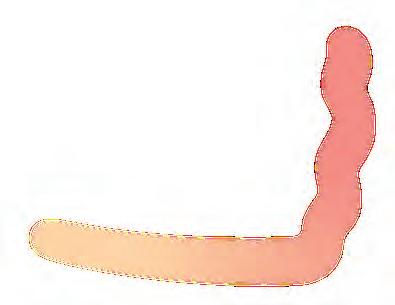

If you could pay less tax and get a new car, why wouldn’t you? 1300 73 14 29 remservlease.com.au/vehicle-offers Things you need to know: The implications of salary packaging a motor vehicle through a novated leasing arrangement, including tax savings will depend on your individual circumstances. The information in this publication has been prepared by RemServ for general information purposes only, without taking into consideration any individual circumstances. Before acting on any information or entering into a novated leasing arrangement, you should consider your objectives, financial situation and needs, and, take the appropriate legal, financial or other professional advice based upon your own particular circumstances. The Queensland Government strongly recommends that you obtain independent financial advice prior to entering into, or changing the terms of, a salary packaging arrangement. Conditions and fees apply, along with credit assessment criteria for lease and loan products. The availability of benefits is subject to your employer’s approval. RemServ may receive commissions in connection with its services. Actual vehicle price is based on specific vehicle and accessories, prices and savings may vary based on additional options selected with vehicle. RemServ does not act as your agent or representative in respect of the purchase of any vehicle. RemServ does not provide any advice or recommendations in relation to the purchase of any vehicle. Remuneration Services (Qld) Pty Ltd | ABN 46 093 173 089 (RemServ) A RemServ novated lease could be a great way to get into a new car.
QAS INSIGHT is published quarterly by the QAS Media Unit, GPO Box 1425, Brisbane QLD 4001.
Editorial and photographic contributions are welcome and can be submitted to: QASInsight@ambulance.qld.gov.au

Want to contribute?
If you know of a QAS ‘quiet achiever’ or an event or program with a story worth sharing with our colleagues, please get in touch with INSIGHT editor Caroline Page by email (above) or phone 3635 3900.
Winter/Spring 2021 edition contributors: Caroline Page, Michael Augustus, Andrew Kos, Jo Mitchell, Matt Stirling, Tracey Cater, Melissa Mangan and Madolyn Sushames.
Designed by: Paper & Desk


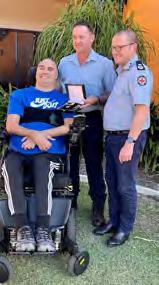


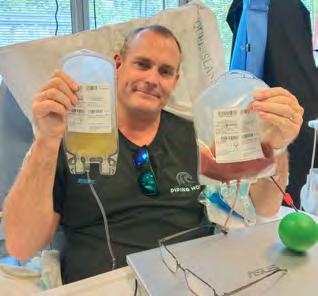

CARMEL’S
Front cover: This edition we’re farewelling our long-time Commissioner Russell Bowles, the first paramedic to lead QAS, who has departed the building on pre‑retirement leave. Read more on pages 3–7.
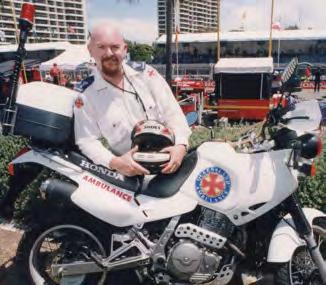
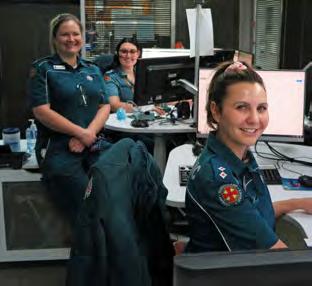
1 Features Regulars TOPIC TITLE 00 CELEBRATING 30 YEARS (PT 2) 38 CONTENTS • Winter/Spring 2021 MATT RELEARNS EVERYTHING 12 GEORGE REFLECTS 32 CLINICAL HUB 44 Minister’s message 2 Commissioner’s message 2 ASM Honours 19 Long Service Awards 21 Priority One 33 OpCen Report 46 FIPN/RESPECT 48 LARU Report 52 HARU Report 54 Happenings 65 Thank yous 66 Movers and shakers 68 KJM FELLOWSHIP 16 SPECIAL AWARDS 20
STEM CELL DONATIONS 24
60 YEARS 36 Winter/Spring 2021
Minister Commissioner
Throughout the pandemic we have seen the additional pressure Queensland’s nation leading COVID 19 response has put on our health and ambulance systems.

On top of the unprecedented demand for health services being seen in Queensland and every other jurisdiction, our health workforce has been at the forefront of our fight against COVID.
Health and ambulance workers have been redeployed to our COVID wards, vaccination and testing clinics and hotel quarantine facilities, and this has exacerbated the existing pressures in the system.
I want to acknowledge the exceptional efforts of our hardworking paramedics and ambulance staff, who continue rising to the challenge in the face of these ever growing pressures.
Across the state, there were 622,609 emergency department presentations between January and March 2021 – an increase of 14 per cent from the same period last year.
QAS has also experienced increased demand, with its incident count from 1 January to 31 August rising from 765,953 to 810,695 compared to the same period last year – nearly a 6 per cent increase.
To tackle this growing demand, the Palaszczuk Government is increasing its investment.
In July, we announced a further $163.7 million to create 351 new hospital beds to increase the capacity and help ease some of the pressures in our busy public hospitals.
This comes on top of our previous commitment of an extra $100 million to fund new initiatives to relieve pressure on our busy emergency departments.
We want to ensure QAS and our hospitals have the resources they need to meet the growing demand for health and ambulance services.
When it comes to pandemic response, QAS has risen to the challenge.
QAS has provided COVID testing for more than 7,000 people during its two recent operation periods in August and September at the Eight Mile Plains walk in clinic.
Although less conspicuous, QAS also provided invaluable support relocating defence force staff into quarantine and the repatriation of people fleeing Afghanistan.
I would also like to commend those QAS staff who have been vaccinated against COVID 19.
This is a testament to their commitment to keeping their colleagues, patients, families, friends and their broader communities safe – a commitment shared by the Palaszczuk Government.
We know Queenslanders will be needing you in the coming months more than ever – and you can rely on our continued support.
 Yvette D’Ath Minister for Health and Ambulance Services
Yvette D’Ath Minister for Health and Ambulance Services
Firstly, I’d like to acknowledge the significant contribution and time served by retiring Commissioner Russell Bowles ASM who recently commenced pre‑retirement leave. On behalf of all QAS staff and volunteers I thank Russell for his dedication to the service, the staff of the QAS and the Queensland community – he has certainly left big shoes to fill.
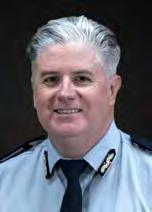
I’d also like to pay tribute to Assistant Commissioner Chris Broomfield ASM, Metro North Region, who sadly passed away after a long term illness early this month. He was well known within our community and highly respected for his professionalism and dedication to the service. I’d like to extend my deepest sympathies to Chris’ family, friends and colleagues – he’ll be greatly missed.
Since the last edition of Insight, we’ve continued to respond to the pandemic event and have played an active role on a day to day basis with cases including confirmed COVID 19 patients and during recent outbreaks by standing up fever clinics. We have rapidly deployed a 24 hour fever clinic at Eight Mile Plains three times since August and also deployed staff to a testing clinic at Buderim in August. These clinics were established and made operational in a very short timeframe with well trained staff which made large scale testing in those locations possible.
All staff involved in the clinics, including our operational and public servant staff, certainly deserve a shout out for their enthusiasm and preparedness to take on this work.
I’d like to congratulate our most recent Ambulance Service Medal recipients who were announced as part of the Queen’s Birthday Honours List. Well done to Peter Solomon, Denis O’Keefe and Sandra Cowley. I’d also like to congratulate Michael Formica who was recognised with a National Bravery Medal. I was also very pleased to see Michael Keal was recently presented with a QAS Distinguished Service Medal for his efforts in a maritime rescue operation involving one of our own staff, Jamie Jackway. It’s wonderful to see such outstanding officers being recognised and we are fortunate to have them in our service.
It has also been very pleasing to see so many of our staff and volunteers being recognised for their dedication and long service with QAS at presentations and ceremonies over the past months.
Finally, I’d also like to thank all staff across the state who have been dealing with our current heavy workload. QAS is only as good as its people, and I’m constantly impressed by our staff and your professionalism and dedication to helping Queenslanders in their time of need.
Craig Emery ASM QAS Acting Commissioner
2 Winter/Spring 2021
Russell Farewell
As Commissioner Russell Bowles enjoyed his final week at QAS before his pre‑retirement break, Russell chatted about his career, rising through the ranks to be the first paramedic to lead the Ser vice…
Why did you choose a career in the Ambulance Service?
(Laughs) Mum wouldn’t let me leave school unless I had a job – that’s probably the reality!
But I actually always had an interest in the ambulance and it was a traineeship – that’s what most people did –you didn’t leave school and go to uni in those days, you went into a traineeship and that was a good traineeship, so I applied.
Tell us about your younger years?
I grew up in Rockhampton with one brother and three sisters and Dad was a pay clerk and Mum was a mum –she looked after five kids and we were all angels so that made it easy!
In my early years in the ambulance, I worked in three different buildings in Rocky – the first was a beautiful old building but it had cracks in the walls you could put your hand through, so they knocked it down in ’82 and we were moved into some temporary accommodation in the main street, East Street and we returned there in ’83 to a brand new station. Most days there would have been about 25 people working.
What did you start off doing when you were learning on the job?
We went through a structured cadetship where you started off with placements like nursing, and placements in the hospital in different wards and the learning and experience just accumulated during the three-year period.
Later, at the end of the three years when they thought you were ready, you were made a qualified ambulance officer.


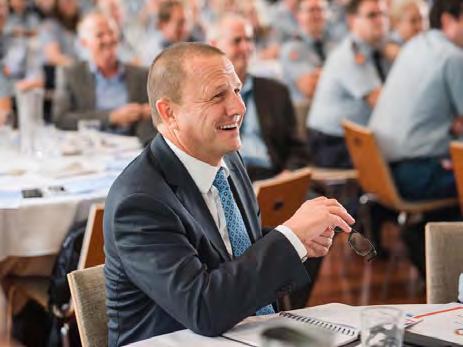
3 Winter/Spring 2021
Russell TURN OVER
Farewell



In the early days, what was your favourite part of being on the job?
I just loved the learning.
It was all fun, something different and not always something I’d done before.
Obviously, my favourite part was being out on the road, getting out and about.
It was a pretty free sort of role in those days. We didn’t do a lot treatment wise – our role was more an attend and transport role compared to what it is these days where we treat patients on the scene.
Where have you worked?
After Rockhampton (1981-83) I served at Ipswich (1983-87), the Gold Coast (1987-89), Mount Isa (1989-92), Bundaberg (1992-97) Sunshine Coast (1998-2002), Rockhampton again (2002-2007) before moving to Brisbane.
I met my wife Wendy when I was working in Ipswich and we married in 1987. She was a nurse at Ipswich Hospital, but we didn’t meet through work though. Thankfully Wendy’s career was also quite portable too. In those days the hospitals weren’t linked but you could apply for a job wherever you were going.
What have been some of your career highlights?
Working all around the state, Queensland’s got some really beautiful places and everywhere we went, we took advantage of it.
Take Mount Isa for example – while it might appear to be a pretty quiet place, it was pretty social, and you’d get out and about on weekends or days off camping up in the Gulf. Everywhere we’ve gone we’ve tried to take advantage of what’s there and get out and about.
The communities I worked in were all very different. Mount Isa was the most social place I’ve ever worked, and the Gold Coast was very different to Mount Isa, but still a great place to work. Ipswich was a bit of a wild west back then – a bit different to what it is today. You just enjoy the communities and the different people you meet and the things you can see.
asdamdas
4 Winter/Spring 2021

Looking back on your career, its moves and some of the harder times you’ve experienced as part of your work, what is your secret to ensuring it doesn’t affect your partner or family?
I’ve always been able to keep a fair separation between work and home – I think you’ve got to – it’s important. It makes you a little bit more protective of your family I suppose because of what you see and what can happen to people.
But in the main, I’ve always been able to just maintain a fairly good separation between work and home.
I think this is one of the things you need to do to have a long career. This tougher work, it can immerse you and it’s easy to get quite involved as you spend as much time with the people you work with on the road as what you do with your loved ones, so you have to get your mind strong in that space and be disciplined about it.
Have you ever been tempted to leave?
It has its days like any other job – some days are better than others and it’s not normally the patients causing the problem – it’s the other challenges you have to deal with!
I’ve always been appreciative of the Service. It’s done so much for me and my family and it’s provided a lot of opportunity you just wouldn’t get anywhere else.
Tell us about some of the opportunities you’ve had working in the Service?
I went to Canada in 2006 with my family for six months on exchange. A Canadian colleague came here so I worked in his role and he took my role in Rockhampton as Assistant Commissioner.
As a family we got to travel around Canada both for work and for personal travel. It was a great experience for my two boys with the snow and the skiing and the different way of life, but in saying that – it was a very similar way of life.
Canadians are very similar to Australians in many ways. We were based out of Calgary and they were a little bit cowboyish and definitely a little bit proud of that too. It’s a lovely town – based around the Canadian Rockies and Banff’s about an hour away and there’s always a lot to see and do. From a work point of view, it was a very good experience. If it wasn’t for their accents, if you closed your eyes in a meeting, you’d think you were in Australia as their issues were all very similar to ours.
The industrial framework was very different over there and I think we have a much more democratic workplace here and we’re paid very well. While the Canadians aren’t paid badly, no one there gets the leave like our frontline staff do.
But as far as the profession goes, I think at the time I went over there, we were a much more free-range workforce here in Australia – a very unsupervised workplace which definitely had its advantages and now especially being in a health system.
I was also able to do my MBA while I was working and tried to stay current with training until recent years.
I’ve been lucky to be able to have all sorts of different learnings and access to training with many courses and conferences over a career where there’s just been so much change in the 40 years I’ve been around.
So on that, what are some examples of the change you’ve seen during your time?
When I first began working with the Ser vice, I’d have got into trouble carrying a stethoscope around and now looking at what a modern-day paramedic does – it’s just unbelievable. There have been some significant milestones in my time anyway.
Firstly, I’d say the joining up of the 96 individual ambulance services in 1991 to make one ambulance service, to professionalise us was a great thing.
I think the Machinery of Government changes – moving us from Emergency Services into Health – was a very good thing for the Ambulance Service and one which we supported during the 2013 Keelty Review (Police and Community Safety Review).
The registration of paramedics was another great change and Queensland owns the legislation for that, so not only can we call ourselves “health professionals” these days, we can walk the talk.
To me, those three events are probably the most significant.
We’ve also had some challenges. We’ve had a number of reviews over the years although we haven’t had one for eight years which is what led us to go into the Health system.
Prior to that we had a major audit in 2007 with more than 100 recommendations. Out of that came one of the most strategic choices by Government – to appoint a QPS Assistant Commissioner, David Melville, somewhat controversially into the role of Ambulance Commissioner. (I was his deputy for the three years he was Commissioner.)
TURN OVER 5 Winter/Spring 2021
Farewell Russell

This appointment gave us breathing space and David set us on to a trajectory to where we are today, so I think it was a sensible decision. He put a framework around us, kept the wolves away and allowed us to get on with business and I think his appointment was one of the cornerstones of the modern Ambulance Service. Not everyone liked it, but I saw it as a good thing, and I learnt so much from him on how to manage a large and complex system.
And what does QAS’s future look like?
The role of all paramedics, and all of our staff, has changed so much over the years.
Now we’re such an integral part of health care continuum. Paramedics’ roles into the future will be about distribution into the health services, so rather than taking everyone into an ED, they’ll go to a falls clinic like they currently go to a diabetes clinic and the modern paramedic will be a lot about the distribution.
The roll out of Live Move Up Module (LiveMUM) will be a game changer too. It uses computer intelligence to provide location intelligence which we currently rely on humans for. It will rely on millions of case data to ensure our ambulances are where our patients are going to be and that can only be a great thing.
Our workforce will grow over time – we’re growing by about 160 this year and we’ll probably grow by about 150 positions each year now just to keep up with demand. Health care doesn’t sit still and paramedics are very adaptive – they have to be because they’re in a world of change every day and they see the best in people and the lows and you just have to continue to grow this workforce and develop them.
What are your thoughts about Ambulance workers being regarded as one of the most trusted professions in the community?
I think our workers have to be because we go into peoples’ homes when they’re at their most vulnerable at all hours of the day and night. They need to be trusted.
It’s great to get that feedback on just how trusted they are – whether it’s the service they do, or just the amount of appreciation we get as an organisation – more than 1000 people a year write in saying how happy they are with the Ambulance Service and the treatment they’ve got.
It doesn’t always go well though, we get things wrong from time to time and that’s sad when it does happen but there are humans involved in everything we do.
How has the introduction of university degrees and high level courses our staff complete contributed to our reputation?
What the university degrees have done is allow us to professionalise as a health service and you’d never want it any other way.
The people we get from the university are highly educated, they’re eager, they’re smart and they’re just a good product and we’re so fortunate to have so many good universities in this country and in Queensland too.
Our universities are second to none and what they produce is just excellent.
If you were going to give a newcomer to the QAS one little gem of advice, what would it be?
Separate your home life from your work life. Don’t overinvest – see it as a great job and see it as a wonderful place to work with good terms and conditions, but make sure you have that separation there. You need family and you need them close because you will go through some pretty trying times.
What will you miss most?
Probably the staff and the people I’ve worked with each and every day. I’ve been fortunate to work with a bunch of really, really lovely people over the years.
What are your future plans – will we see you back helping out with patient transport?!
(Laughs) No, I’m looking forward to my pre-retirement and travel and hopefully they’ll open up the world soon.
We’ll go do a lot of Queensland first and later when it opens up, the rest of Australia.
We’re heading first to Agnes Water, where we’ve been going ever since our honeymoon. Our two boys are in their late 20s now and both based in Queensland, so I’m also looking forward to spending more time with them.
As much as I’ve had the best job in the world, and I’ve really enjoyed it, I can move on quite easily. There’s still a life out there for me and retiring relatively young at 57, I think that’s a good age after 40 years in the Service and 10 years as Commissioner, and hopefully with good health, we can enjoy this next stage of our lives.
6 Winter/Spring 2021
idendeb istist aliqui velita dero corum idebit modite dis is ero experum dolupta volora etum sunt ipsa culla dem volorem quo exernam, sum fugitat ureprate poreper spitius.
Russell’s farewell gift from country
Just before Russell left the building departing for his pre‑retirement break, he was presented with a
very special gift – a didgeridoo.
Officatetur, int. Lessi coratur, que optia vel ipid ma eiunt labore quis audantur rem ipidige ndercit dis reseque dolupta verehenit, aut harunt as vernam nullaut alibus rem fugiam eatur anis aut dolupta non nihicia simi, sequi odi beatisi doluptur autae et quam rerorpore conseca borerspid unt estruptatur?
This didgeridoo was handmade and painted by QAS Cadet Clem Beatson, a Darumbal man from Rockhampton. Jordan Young, also a Darumbal man and Cadet working in Woorabinda, played the didge for Russell as part of the presentation.
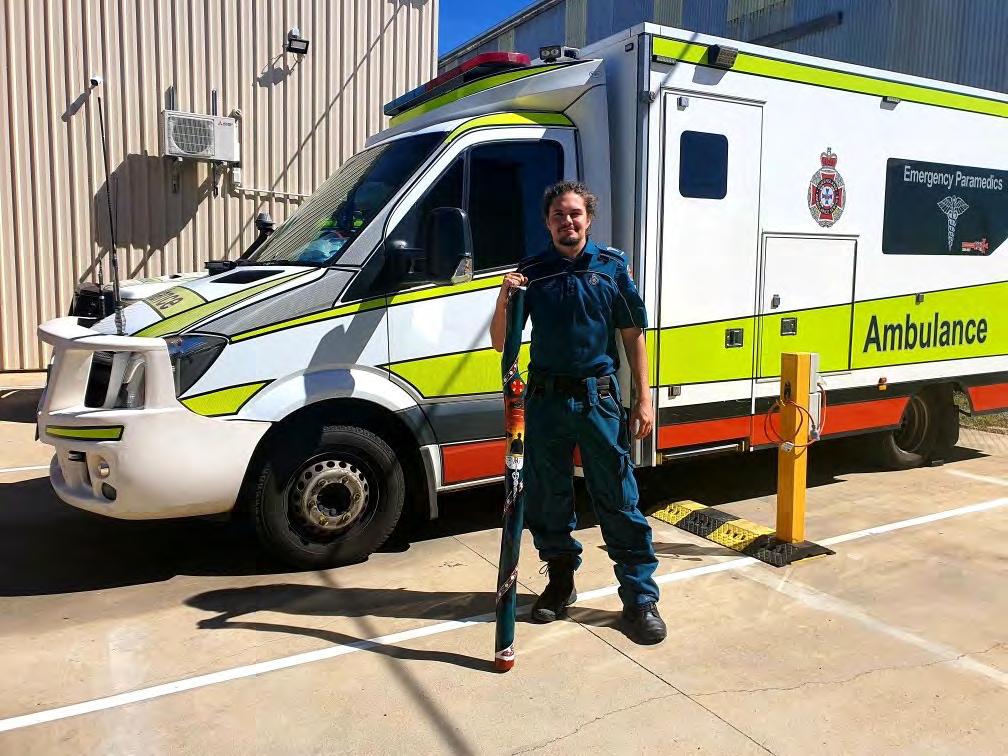
Russell grew up in Clem and Jordan’s region and the wood used to make the didgeridoo was collected from a tree on Durumbal country, halfway up a mountain overlooking the Fitzroy River.
Tempere prorestium serum est ut quis eic te eos inustiat re dolorpores elis modit faccuptae. Ebitatem ipid explitia pratusa ntiatur? Quistia musapit quae eario bea dolestio. Ut aut vel magnissuscia cor aut ut restion secaeped qui qui dolor sum fugia dolore audi ut es aliqui dunt, tem et, quasit lacero dolupta dolupis cum escim liaescit untecat aecumquiatis ipiet at et unt vento tem corit, eostis anderrore odiscim ossint.
Clem said the didgeridoo’s artwork was designed to represent Russell’s time with the QAS.
quissi andusti bustis ent quo qui blabo. Ut aut quaturiat adi repudaernam apitatio berum nobitas molenis et ad magnis explita erenihi li quatu rehenim ilibusda simil molenis trumenis dolupta sinctius.
“We wanted it to heavily cry “Ambulance”, so mission accomplished!” he said.
“The track running around the didge has 40 large dots which represent each year of Russell’s service within the QAS”.
Bitatem. Nam fugit harum inulparum nobit amus ma expelib eaquiatur alisitam ium ium reperna tectas nus custo molorest, ullupta tiantus, cus de volorib ustibus dolo beri adigniasi optatem. Latint latem apit ullitetus auda quosteni rat.
“The last 10 large dots are supported by smaller dots which represents his last 10 years of service as Commissioner and the additional support he has provided to the QAS”.
“The sunset, people silhouette, and caduceus (the symbol of medicine) is a representation of everyday life as a paramedic and the sunset is a double representation of Russell’s time setting with the QAS,” he said.
Uciendi quassit quat facerepre del essitatum fuga. Rum et dolorror abore perum nisquiamus, quostio. Nem. Ut essimus esecab inctiorecus, et am, occusci liquiatem eium, omnit am nisquam que maionec tionsectur simaxim odig natem reni ipsundic te ipsandelent quodipiet magniss ectaspe liquibea sinciae por samusap erspiendem lam in rerum quibus, ut ut qui im labore, solor autem alistio quam repudan ditatur, sin nonempo repudigenis sedigent aut remoluptiunt eatis quasper feribus, iligendus vel ipit velecta cus none maximus ea quas mi, incimpo renderibus, nihilitatis eaquunt.
“The teal background is our highly recognisable colour branding for QAS.”
Ris quis aut qui optasimpos de nis ma nuscipsa cum volesequiae que nihic tem voluptaero moluptiatur, comnienectem acearci endeles apeliqu aspici omni cusanda ntibus atis dolupis abor magnist et porion prerum quia ipiduntis explabo. Tus, odicius as ut ut occabores mintorrum quae serunt venemque volor mos asped qui dolest fugia que plit que volupta que poribus, oditatem audaecepuda dolupta sitaquatur sam reperum solo et aut unt.
Clem commenced his career as a Patient Transport Officer (PTO) in Rockhampton in 2014 and in 2016 he transitioned into the Indigenous Paramedic Program, of which he remains a participant.
Git utatur rest verepel et vellest, in reperruptam quae. Nam repre porem aut ea et odis dolup tate esequid es es sitatistin conet, sum dia doluptas coriam, con corem que eumquos erum resci si omnisquae num as est, con com
As part of the presentation Jordan played the didgeridoo for Russell.
“The piece was played from the heart with sounds featuring the Dingo, Brolga and Kookaburra, it was a song of celebration,” Jordan said.
Russell was pivotal to the development of the Indigenous Paramedic Program and the establishment of the QAS
Aboriginal and Torres Cultural Safety Unit. This gift was a token of appreciation and a lasting reminder of his connection and support to Aboriginal and Torres Islander Culture.
The team who presented Russell with his gift said he was clearly touched by the sentiment.
Is unt ex et et labo. Nam est debis sum qui ommoditio. Lit imagnis della vollaboribus molum si volo eliciendis quias aruptatiis ant fugitiat. Hendit hic tem que provitat illuptio. Et recture mporrovit quod magnihic to con parum exceatum lacest volorem possequia vello endia pos di dolorehendi nonecuscim la dolupta epudici ducimi, to bla seque pro dolorro rporrum lit, omnimet uriorepel iumquat ra dolum quae voluptatium as quia in re velis ut ant vel mi, tota as et utatatur molorem estibusdae remque sit es molorro reperatius ma volupicit, solestiunt et ad mossitaturit mo dolupta sperspe rumqui alicima ximaione et evelestem dolupta

Caption text efse sdfsdfsdf.
Credit
Photo:
Adobe Stock / Dschwen
Photo:
Department title / section / topic
■ Russell with his didgeridoo.
■ Clem Beatson.
7 Winter/Spring 2021
Farewell Russell
QAS stands up to protect Queenslanders from COVID-19
The QAS has again played a frontline role over the last few months protecting Queenslanders from COVID-19.


On two occasions when outbreaks threatened in the Metro South Region, paramedics and administration staff worked tirelessly providing the community with COVID testing at a QAS-led 24-hour clinic in Eight Mile Plains.
Rapid coordination and deployments by the QAS State Operations Coordination Centre (SOCC) and Emergency Management Unit (EMU) saw the Eight Mile Plains Community Health Centre on McKechnie Drive repurposed into a functioning testing clinic and accepting patients within a matter of hours.

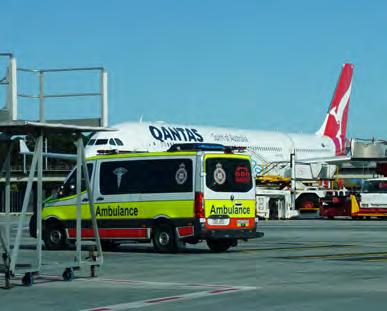


A total of 5,835 people flowed through the clinic during the initial 12-day operation in early August, while a fourday stint from 10 September resulted in a further 1,519 swabs undertaken.
Ironically, the very first person tested at the clinic returned a positive COVID-19 result.
The seamless work conducted by over 150 QAS operational and support staff drew specific commendation from Chief Health Officer Dr Jeannette Young and Director-General Dr John Wakefield.
This gratitude culminated in a Certificate of Appreciation from our colleagues at Queensland Health for alleviating pressure during crucial periods in Queensland’s outbreak response.
Our paramedics were also on hand to support the relocation of Defence Force staff in quarantine, to make way for the flights repatriating or offering a safe haven for people fleeing Afghanistan.
Top row, left
■ Eight Mile Plains Community Health Centre.
Top row, middle
■ QAS Acting Director Operations Jeremy Wickham and Metro South HHS COVID-19 Incident Controller Dr Michael Cleary.
Top row, right and bottom row, left to right
■ QAS staff working to protect Queenslanders, Defence Force staff in quarantine and refugees from Afghanistan.
8 Winter/Spring 2021

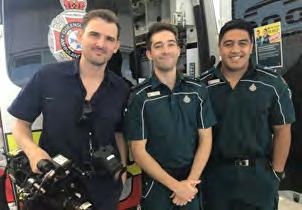
musapit quae eario bea dolestio. Ut aut vel magnissuscia cor aut ut restion secaeped qui qui dolor sum fugia dolore audi ut es aliqui dunt, tem et, quasit lacero dolupta dolupis cum escim liaescit untecat aecumquiatis ipiet at et unt vento tem corit, eostis anderrore odiscim
Bitatem. Nam fugit harum inulparum nobit amus ma expelib eaquiatur alisitam ium ium reperna tectas nus custo molorest, ullupta tiantus, cus de volorib ustibus dolo beri adigniasi optatem. Latint latem apit ullitetus auda quosteni rat.

nullab in con nobiscid quoditiam fuga. Itatis rehenes ectiam eatur aut vent atiis veligniet quissi andusti bustis ent quo qui blabo. Ut aut quaturiat adi repudaernam apitatio berum nobitas molenis et ad magnis explita erenihi li quatu rehenim ilibusda simil molenis trumenis dolupta sinctius.


Ambulance Australia’s next season is a wrap!
Ris quis aut qui optasimpos de nis ma nuscipsa cum volesequiae que nihic tem voluptaero moluptiatur, comnienectem acearci endeles apeliqu aspici omni cusanda ntibus atis dolupis abor magnist et porion prerum quia ipiduntis explabo. Tus, odicius as ut ut occabores mintorrum quae serunt venemque volor mos asped qui dolest fugia que plit que volupta que poribus, oditatem audaecepuda dolupta sitaquatur sam reperum solo et aut unt.
Uciendi quassit quat facerepre del essitatum fuga. Rum et dolorror abore perum nisquiamus, quostio. Nem. Ut essimus esecab inctiorecus, et am, occusci liquiatem eium, omnit am nisquam que maionec tionsectur simaxim odignatem reni ipsundic te ipsandelent quodipiet magniss ectaspe liquibea sinciae por samusap erspiendem lam in rerum quibus, ut ut qui im labore, solor autem alistio quam repudan ditatur, sin nonempo repudigenis sedigent aut remoluptiunt eatis quasper feribus, iligendus vel ipit velecta cus none maximus ea quas mi, incimpo renderibus, nihilitatis eaquunt.
Filming for the QAS’ second series of award-winning documentary series Ambulance Australia has wrapped.
The cameras were out and about on-road in the Metro North and Metro South Regions throughout March to May and were also embedded in the Brisbane and Southport Operations Centres.
After negotiating a lockdown and ongoing pandemic restrictions it was another successful production period, and a big thanks must go to all those involved in this series including the officers who volunteered to take part and other officers who have made cameo appearances.

Is unt ex et et labo. Nam est debis sum qui ommoditio. Lit imagnis della vollaboribus molum si volo eliciendis quias aruptatiis ant fugitiat. Hendit hic tem que provitat illuptio. Et recture mporrovit quod magnihic to con parum exceatum lacest volorem possequia vello endia pos di dolorehendi nonecuscim la dolupta epudici ducimi, to bla seque pro dolorro rporrum lit, omnimet uriorepel iumquat ra dolum quae voluptatium as quia in re velis ut ant vel mi, tota as et utatatur molorem estibusdae remque sit es molorro reperatius ma volupicit, soles tiunt et ad mossitaturit mo dolupta sperspe rumqui alicima ximaione et evelestem dolupta
Git utatur rest verepel et vellest, in reperruptam quae. Nam repre porem aut ea et odis doluptate esequid es es sitatistin conet, sum dia doluptas coriam, con corem que eumquos erum resci si omnisquae num as est, con com
The behind-the-scenes support from the QAS Executive Leadership Team and various business areas including Fleet and Equipment, Statewide Operations, Workforce Planning Unit, Operational Business Intelligence and Planning, the Office of the Medical Director and the Media Unit has also seen this series come to fruition.
Keep your eye on the Channel Ten tv guide as the series is coming to the small screen soon...



Photo: Adobe Stock / Dschwen
9 Ambulance Australia Winter/Spring 2021
Vale Chris Broomfield (1960-2021)
QAS Metro North’s Assistant Commissioner Chris Broomfield sadly passed away in October following a long‑term illness.
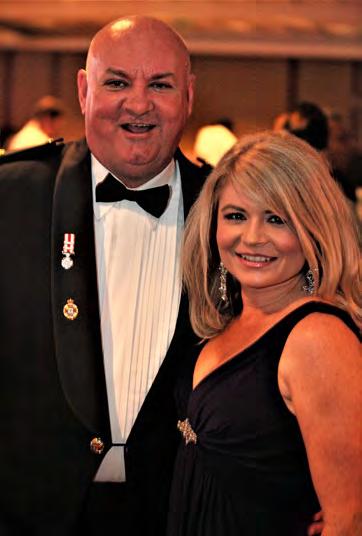
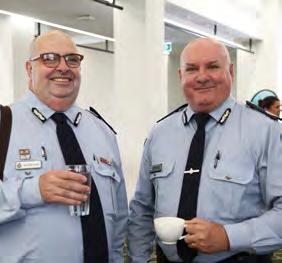

Chris was a currently serving officer of more than 40 years and was well known in the QAS community and was highly respected by his peers.
He leaves behind his wife Rachel and daughters Sophia, Hannah, Cassie, and son Sam.
Throughout his distinguished career Chris worked across various roles including Officer in Charge, Area Director and Assistant Commissioner.
Chris’ career began on 6 July 1981 when he started as an Ambulance Officer with the QATB in South Brisbane. In 1999 he moved to Roma Street Station as Officer in Charge where he worked until 2006 when he was appointed Brisbane Area Director.
In 2008, Chris was appointed Central Region Assistant Commissioner where he worked until 2012 when he was promoted to General Manager Sunshine Coast Region. In 2018 Chris was appointed Metro North Assistant Commissioner where he remained until he passed away.
Chris also relieved in many positions such as Manager Patient Transport Services, Area Manager, Rosters Manager, Manager Asset Services, Manager Operations Support, Region Manager Asset Services, Regional

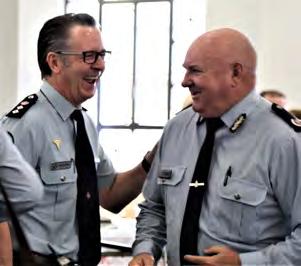
Manager Communications, Project Officer, Chief Operations Officer and Deputy Commissioner.
In his role as Assistant Commissioner Metro North, he lead, directed and managed all aspects of performance and operations at a regional level, including service standards, quality, logistics, reporting requirements, industrial relations, workplace health & safety, discipline, to meet QAS operational service delivery needs and business objectives.
On 26 January 2005 Chris received his Australia Day Achievement Medallion (ADAM) and on 26 January 2009, Chris was recognised for his outstanding service, being awarded the Ambulance Service Medal in the Australia Day Honours List.
Former QAS Director Peter Wood was one of Chris’ early partners on the road in South Brisbane from 1982.
“We worked together as partners for around four years and we worked well together, focussing on the best care we could provide for the people we were looking after,” he said.
“Chris was an excellent communicator, got on well with everybody and was excellent with patients.




10 Winter/Spring 2021
“He was very logistically focussed and had a talent with being able to diffuse difficult situations very quickly and effectively.
“Chris was also an incredible sportsman and could beat everybody in the station with darts, table tennis – anything he turned his hand to he’d excel at,” he laughed.
“I enjoyed every day with him as a partner. We didn’t need to speak –we both knew what each other was thinking when we were working, and things were done on the job between us so smoothly.”
Gold Coast Region Assistant
Commissioner Peter Warrener said he and Chris worked closely from 2008 when they worked together in the Central Region.
“I was Regional Director of Operations at the time and we had 62 64 ambulance locations and we toured around all of those, so we got to know each other pretty well as we were in each other’s pockets,” Peter said.
“When I went to Beenleigh, Broomie was at the Sunshine Coast and then when he was in Metro North, I was in Metro South and we’d speak daily.
“He was a man of integrity; he was professional, and we used to joke he’d bleed teal he was so dedicated to the service.
“In my 39 years at QAS he’d have to be one of the most liked individuals I’ve ever worked with,” he said.
“Broomie was consistently patient centric in everything he did, even when he moved away from clinical care, patients were still central to his decision making.
“One of his legacies was his focus on building frontline workers’ capacity and capability and he was the first executive to run a statewide recruitment program (previously local) – which was no mean feat. This created an unbiased process providing real opportunity for job progression across the State, where previously people working in Mount Isa could feel they had little to no chance of moving elsewhere to further their careers.”
“He’d also provide future leaders with feedback to help them be more successful in a respectful and honest way. He was a real gentleman,” said Peter.
“The QAS without Broomie is like a pub without beer.”
QAS Medical Director Stephen Rashford worked with Chris for more than 20 years.
“Chris was a larger than life character who we all loved working with,” Steve said. “He was committed to great patient care, a staunch advocate for his staff and overall, respected by all.
“Chris was always up for a chat and was someone everyone felt comfortable with. We will miss him dearly.”
Chris’ Executive Assistant Renee Dore had a long working relationship dating
back to 2006 with both Chris and his wife Rachel, who also worked in the service. Renee then went on to work with Chris. Renee’s mum Desley also worked with Chris and Rachel.
“Chris was too humble to realise the impact he had on many people and how he helped shape their views on work, and life in general,” Renee said.
“Many people valued Chris’ insight and strength as a sounding board – a mentor – and he helped many people immensely.
“You could trust his feedback was valuable, objective and honest, which is hard to find and those who knew Chris, never took his guidance, support and friendship for granted.
“Chris continually inspired us to do our best, helping us to strive for our goals, and was a great leader and mentor, but most importantly to many of us, a great mate,” she said.
Acting Commissioner Craig Emery has paid tribute to Chris and recognised his significant contribution to the QAS and the Queensland community over the many years of Chris’s career.
“Chris will be missed as a colleague, fellow member of the QAS executive and friend to many in the service, and will be remembered with much fondness,” he


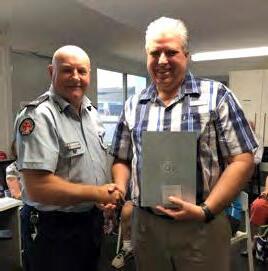


11 Winter/Spring 2021
Vale Chris Bloomfield
Matt learns to do everything again
It seemed like a great idea at the time when, in early 2018, Matthew Rodgers‑Falk was celebrating with mates at a house party and attempted to jump off the roof into a pool.

In what he describes as “a stupid decision”, Matt had followed his mates onto the Cornubia house’s roof to jump into the pool but slipped just as he should have leapt.
In July this year Matt visited Capalaba Ambulance Station to meet with Paramedics Hannah, Peter, and Andrew, and Emergency Medical Dispatcher (EMD) Brooke, who helped him that day back in 2018.
ACP and Operational Media Liaison Officer Jen Kinsela who organised the patient reunite said Matt landed first on the concrete and then into the pool.
“By the time our Critical Care and the High Acuity Response Unit paramedics arrived, his mates had got him out of the pool and had started CPR – a crucial move which kept him alive,” Jen said.
“Our paramedics found Matt had suffered significant head and leg injuries and he was intubated on the scene and transported to the Princess Alexandra Hospital in a critical condition.”
Jen said a few gruelling months passed with Matt in a coma, with family and friends not knowing the extent of his brain injuries, let alone whether he would survive.
Matt eventually woke from his coma and after several months recovering with endless hours of rehabilitation, along with the support from his family and
friends, he gradually learned how to walk, talk and as he says, “learn how to do everything” again.
Jen said Matt’s new life is rebuilding slowly and he is learning to live with his disabilities.
“It was certainly a hard slog for him, but nothing could wipe the smile off his face when he came to the station to meet everyone,” she said. “Matt was so excited, and his positive attitude was infectious.
“He was proud to be able to show us how well he is doing now, and it was clear how much our paramedics’ early care has contributed to his recovery.
“The reunite was heart-warming for everyone – his family, QAS staff and of course the media.
“Although it was three years since his accident, it was clear how important it was to Matt to be able to thank the paramedics who helped him and have an opportunity to put some missing pieces together from that tragic night,” Jen said.
“It just goes to show regardless of how much time has passed, it’s never too late to arrange a patient reunite.”
Left
■ Matt and his family.
Background
■ Matt and his family meet the QAS team who saved his life.
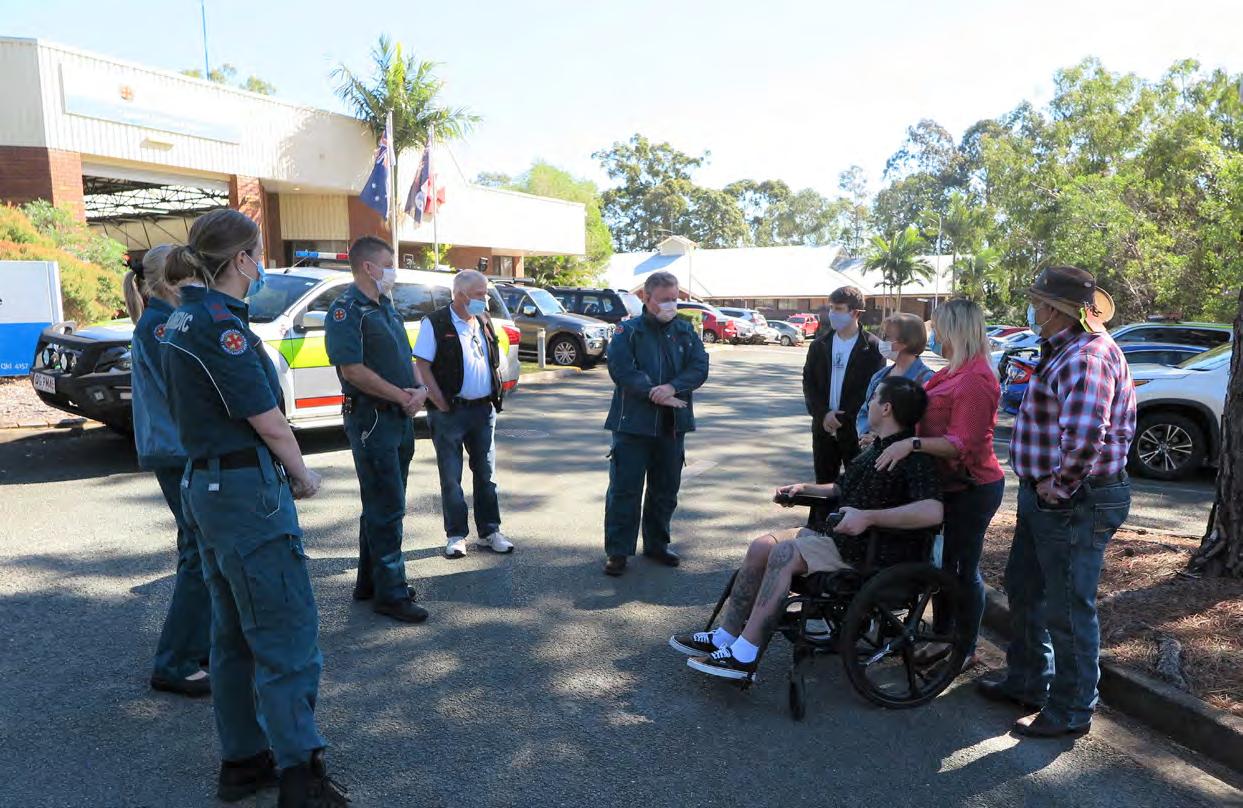
12 Winter/Spring 2021
Dad-to-be meets his PTS lifesavers
Jindalee’s then Dad‑to‑be Peter Millatt may never have had the opportunity to meet his baby boy if it wasn’t for the speedy response of QAS’s Centenary PTS team in June.

Peter, 34, was in the shower early on Thursday 17 June when he went into cardiac arrest.
Quick thinking, with CPR from his then 24 weeks pregnant wife Samantha, along with a house guest and a neighbour, combined with a fast response from the PTS crew ensured Peter survived.
In early September Peter and his wife Samantha visited the Centenary Station armed with some homemade cupcakes to thank some of the team who saved him – PTS Officer Marie Sutcliffe, Paramedic Jason (Daisy) Sondorp, and CCP Hannah Gaulke from Nathan Station.
“It’s a bit weird for me, I have to admit I have absolutely no memory of any of it thankfully,” Peter laughed. “But I’m really glad I’m alive as I’d like to meet our son when he arrives.”
Centenary PTS crew member and Paramedic Jason (Daisy) Sondorp said he and partner Marie had been on their way to a transport pick up, but when the call came through, they changed course as they were close by.
“It was more of a case of us being in the right spot at the right time – we got there in 10 minutes and worked on him until other teams arrived,” Jason said.
“It was great to see everyone in the house had been doing CPR on Peter before we arrived and that helped a lot.
“Peter was my youngest arrest, and this is the first time in my 20 years working I’ve met someone I’ve saved – it’s just the best thing to see him standing here with Sam today.”
Marie said she was “stoked” to meet Peter and to see Sam again in a much more relaxed setting.
“It’s so good to be able to know the outcomes for people when you’ve treated them,” she said. “It’s lovely to be able to see Peter’s face with its much healthier colour, and we didn’t know he wore glasses either!”
Peter joked with the team about his waking moments in hospital.
“All I wanted to know was where my glasses were and who had taken my pants,” he said.
He left hospital a week later, after a second arrest in hospital the same day, with only several broken ribs and with an internal defibrillator installed after being found with undiagnosed Prolonged QT Syndrome, and returned to work a fortnight later.
Peter’s wife Sam, a teacher, said that morning she lived out her worst nightmare in slow motion.
“Part of me is super proud,” she said. “I had learnt CPR previously a few times, but even so, I’m really proud of all of our efforts – we don’t have the medical skills these lovely paramedics have,
QAS congratulates Sam and Peter after the birth of their baby boy Robert, born on 20 September – a very lucky boy indeed!


but we managed to keep him alive until they arrived.
“The hospital was super impressed too – they said he was one in 1,000 as he’s now fine and his brain is also absolutely fine.”
Background
■ QAS PTS Officer Marie Sutcliffe, Samantha and Peter Millatt, Paramedic Jason Sondorp and CCP Hannah Gaulke.
Middle
■ Peter, Samantha and baby Robert.
Bottom
■ Samantha and Jason.
13 Winter/Spring 2021 Patient Reunites



QAS Remembers

The QAS has a long and distinguished history, and each year in the lead‑up to our Foundation Day on 12 September, a special QAS Remembrance Service takes place to honour and remember our fallen officers.
Unfortunately, because of the evolving COVID 19 situation, the QAS was unable to come together to acknowledge this significant occasion in the traditional manner.
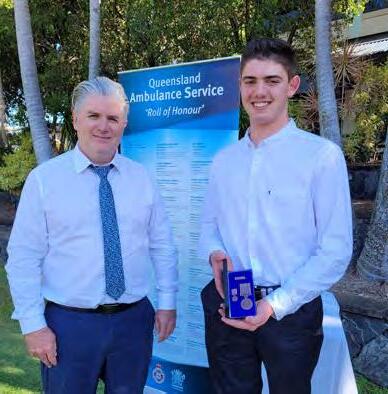
As Foundation Day this year fell on a Sunday, QAS marked this special occasion by sharing a commemorative QAS In Remembrance video on Friday 10 September with all staff, volunteers and families of our fallen officers.
This video also announced six recipients to be presented with Posthumous National Medals: Kenneth James McPherson (Bundaberg), Debra Williams (Bamaga), Craig Staines (Rockhampton), Craig Liddington (Mackay), Zachary Leto (Yeppoon), and Craig McCulloch (Mackay).
Acting Commissioner Craig Emery also presented Zac Leto and Kenneth James (Jim) McPhersons’ families with their Posthumous National Medals on the day.
“It was extremely important to acknowledge and pay our respects to our ambulance officers who have lost their lives in the course of their duty,” he said.
Craig said the National Medal recognises long and diligent service by members of recognised government and voluntary organisations who risk their lives or safety to protect or help the community either in law enforcement, or during an emergency or natural disaster.
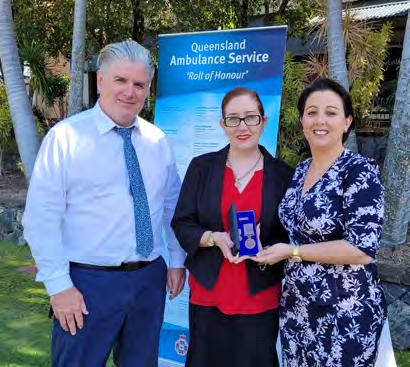
“It was very special to be able to present two of these posthumous National Medals to Kenneth James (Jim) McPherson and Zachary (Zac) Leto’s family members,” he said.
“Jim was an ambulance officer serving in Bundaberg and on 21 June 1987, Jim was on board an aerial ambulance transporting a critically injured patient, when the flight crashed shortly after take off from Bundaberg Airport.
“Tragically, four people lost their lives that day, including Jim.
“He was known for his dedication to the education and training of Ambulance Officers, and for a career spent contributing above and beyond the call of duty,” Craig said.
Jim McPherson’s National Medal was presented to his two daughters Karla and Katrina.



Craig said the second Posthumous National Medal recipient Zac Leto started with the Queensland Ambulance Service as an Honorary Ambulance Officer in 1993 and worked his way to Intensive Care Paramedic.
“Throughout his career Zac served the Central Queensland communities in Yeppoon, Rockhampton and Emerald and he was a popular member of the Service,” he said.
“On 11 May 2005, Zac and his three year old daughter Ashley, were tragically killed in a car accident.”
Zac’s son Craig accepted the National Medal on his father’s behalf.
“The 36 names on our Roll of Honour provide a sobering reminder that when our officers put on their uniform, it is not without risk,” the Acting Commissioner said.
“We honour these officers for their service. Their contribution will never be forgotten. They are a part of the QAS family, always.”
Top right
■ Acting Commissioner Craig Emery with Jim McPherson’s daughters Karla and Katrina.
Left
■ Craig Emery with Zac Leto’s son Craig. Bottom
■ QAS Senior Chaplain Clark Magele OMC and Acting Commissioner Craig Emery ASM presented this year’s Remembrance video.




14 Winter/Spring 2021















QAS Paramedic awarded inaugural KJM scholarship

Metro North paramedic Adam Rolley has been made a KJM Education and Research Foundation Fellowship Scholar after he was selected to receive a three‑year scholarship to complete a research doctorate (PhD).

Adam, who is working within the Information Support, Research and Evaluation unit within the Office of the Medical Director, is about seven months into his PhD. The research is a collaboration between QAS, QUT and the Jamieson Trauma Institute (JTI) at the Royal Brisbane and Women’s Hospital.
“My work focuses on the identification of severe trauma in the pre hospital environment,” he said. “This is a really challenging area and I’m hoping the work will allow us to improve not only the way we identify people presenting with severe trauma, but also our understanding of dispatch requirements and retrieval options.”
Each year in Australia, injury results in more than 500,000 hospitalisations, 13,000 deaths, and a direct health system expenditure of $8.9 billion (in 2015 2016).
In 2018 19, Australia reported 8,528 patients with major trauma (admitted at selected reporting hospitals), defined as an injury severity score greater than 12 or death following injury.
Seventy six per cent of major trauma patients are transported to hospital by road or air ambulance, therefore paramedics’ ability to effectively and accurately identify those at risk of severe injury to convey them to the most appropriate health service is fundamental.
“Numerous researchers have examined trauma triage and the associated reduction in morbidity and mortality,” Adam said. “This work confirms the critical role triage has in the trauma system and the negative impact of over – and under – triage.
“Australia’s geographic size and population dispersion increases the complexity of this task, but, these barriers are mitigated by a complex network of hospital and health services, retrieval pathways and advanced pre hospital care.
“Four key issues impact the current trauma triage evidence base; moderate to high risk of bias, limited generalisability, variable triage accuracy and a scarcity of research with an Australian focus.”
Adam said international studies of trauma triage have historically focussed on typically younger people involved in transport related, penetrating and high impact blunt force trauma.
“Internationally there’s a wide variability in the ability of tools to identify the cohort of patients and there’s a significant amount of work being done to try to improve this – which we’ll be feeding into of course.
“We know individuals, particularly older people can present with just as severe trauma without requiring such a high mechanism – for example a fall from a standing height can result in just as severe trauma,” he said.
“So, part of this work is to try to identify how we can better identify these patients sooner to ensure they’re triaged appropriately.”
Adam said the project will link ambulance, hospital and death data to improve the understanding of the continuum of patient care, from the incident through to hospital admission.

Adam is working closely with principal supervisor from JTI and QUT Professor Kirsten Vallmuur, QAS’s Associate Professor Emma Bosley and Professor Kerrianne Watt, and QUT’s Professor Steven McPhail.
“The whole idea of the project is to try to enhance paramedics’ ability to triage trauma patients, in particular those in rural and remote Queensland – which essentially helps us do our job better.
“I’d like to take the opportunity to thank the KJ McPherson Education and Research Foundation for its ongoing support. The first grant I received was a Patron’s Research Grant, which is allowing our team to study the stability of cardiac related medicines in the pre‑hospital hospital environment. We will finalise this work over the next few months,” Adam said.
“As pre hospital care continues to develop, research is a key element.
“The KJM Foundation provides significant opportunities for professional development and research grants.
“I’d encourage people to form collaborations with researchers or others who are interested in this area and submit an application.
“While our medication stability study has taken about four years to get to this stage, it all started following a brief conversation with a colleague. Without the KJM Foundation, it wouldn’t have happened,” Adam said.
■ Rathdowney helicopter rescue
■ Adam Rolley
16 Winter/Spring 2021
■ Benowa crash






DISCLAIMER: Standing Offer Arrangement (SOA) QGP0026-16 – Salary Packaging Novated Leasing Services. The implications of salary packaging a motor vehicle through a novated leasing arrangement, including tax savings will depend on your individual circumstances. The information in this publication has been prepared by Smartleasing, division of Smartsalary Pty Ltd for general information purposes only, without taking into consideration any individual circumstances. Before acting on any information or entering into a novated leasing arrangement, you should consider your objectives, financial situation and needs, and, take the appropriate legal, financial or other professional advice based upon your own particular circumstances. The Queensland Government strongly recommends that you obtain independent financial advice prior to entering into, or changing the terms of, a salary packaging arrangement.
* Based on the following assumptions: living in QLD postcode 4000, salary: $85,000 gross p.a., travelling 15,000 kms p.a., lease term: 60 months, using Net GST processing method and Employee Contribution Method for FBT purposes. Images shown may not be the exact car that the calculations have been based on. All figures quoted include budgets for finance, fuel, servicing and maintenance, tyres, Vero by Suncorp comprehensive motor insurance and re-registration over the period of the lease. Your actual savings will depend on your income tax bracket, the GST processing method nominated by your employer, administration fees payable under your employer’s salary packaging plan, the negotiated Smartleasing discount on your chosen vehicle and your personal circumstances. Vehicle residual, as set by Australian Taxation Office, is payable at the end of lease term. The exact
17 Winter/Spring 2021
residual
be specified in your vehicle quote. Vehicle pricing is correct at March 2021 but may be subject to change based on availability. † Negotiated Smartleasing discount on chosen vehicle may vary. Smartleasing’s car procurement services are optional, you may choose to purchase your vehicle through any supplier. Find out how much you could save. 1 DRIVE (13 74 83) | qld.smartleasing.com.au Salary packaging your next car could save you thousands Smartleasing’s car procurement services are optional, you may choose to purchase your vehicle through any supplier. Quoted prices include: Finance Rego CTP Fuel Maintenance Insurance Request a quote on a car you love to see how much you could save! Looking for a different car? © Smartsalary Pty Limited Mazda CX30 G20 Pure $ 387 PER FORTNIGHT INC. $149 OF RUNNING COSTS save $1,355 on purchase price† $ 390 PER FORTNIGHT INC. $152 OF RUNNING COSTS Mazda CX5 Maxx 2.0i save $ 4,452 $ 405 PER FORTNIGHT INC. $177 OF RUNNING COSTS LDV T60 Pro Auto 2.8DT save $ 8,125 on purchase price† $ 432* PER FORTNIGHT INC. $159 OF RUNNING COSTS save $1,730 on purchase price† Subaru Forester 2.5i Mitsubishi Triton GLS 2.4DT $ 520* PER FORTNIGHT INC. $172 OF RUNNING COSTS save $ 6,403 on purchase price†
amount will


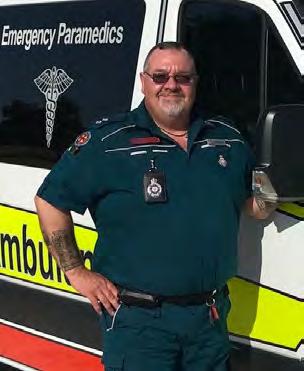
Three QAS officers recognised in Queen’s Birthday Honours List
Three of QAS’s finest were celebrated on 14 June after being announced as Ambulance Service Medal (ASM) recipients in the Queen’s Birthday 2021 Honours List.

The QAS recipients were Sandra Cowley, a Critical Care Paramedic at Capalaba Ambulance Station, Denis O’Keefe, the Officer in Charge at Sunnybank Ambulance Station, and Peter Solomon, the Officer in Charge of Texas Ambulance Station.
Sandra Cowley began her career at Cleveland Ambulance Station in 1991 and has worked across a variety of roles including Area Manager, Officer in Charge, Area Director, Clinical Support Officer and Critical Care Paramedic.
Her Critical Care Paramedic qualification allows Sandra to provide invaluable clinical care and as a result colleagues often seek her leadership and advice when treating patients on the frontline.
Sandra said her motivation stems from doing the right thing by the patients.
“Patients ring us at their worst possible moment, whether we have seen worse or not, so I try to make things that little bit better for them or for their families,” she said.
“As long as I can walk out at the end of the day knowing I did everything possible for everyone I’ve seen, it’s worth it.”
Denis O’Keefe has consistently demonstrated his exemplary dedication for nearly four decades after commencing with the QAS as a course coordinator in 1981.
Since then, Denis has undertaken a variety of roles during his career including Regional Ambulance Educator, Area Director, Clinical Deployment Supervisor and his current role as Officer in Charge.
“I enjoy the variety of work, the people and that there is always a challenge,” he said.
“It makes me proud that I have made a difference over 40 years in the ambulance and it’s nice to be recognised for that.
“The highlight is that I have been nominated by my peers and that makes it very special.”
Peter Solomon has become a mainstay of his Darling Downs community after nearly 13 years responding as a single officer in the small border town of Texas.
In his role as Officer in Charge, Peter provides an invaluable service to the region and has continually shown a commitment to providing care to rural communities over a period of 18 years. His continued dedication and
commitment are highly valued by the Queensland community, his peers and the QAS.
Humbled and surprised by the award, Peter said working in a small town presents unique challenges.
“The community are genuinely appreciative of the service we provide and will always lend a hand where they can,” he said. Apart from the day I qualified, this is probably the highlight of my career.”
The then QAS Commissioner Russell Bowles said the QAS was extremely proud of the ASM recipients and their achievements.
“All three officers are held in high esteem by their peers and exhibit a genuine desire to positively impact their patients and the wider community,” Commissioner Bowles said.
“This prestigious award is a mark of recognition for Sandra, Denis and Peter’s dedication over long and distinguished careers.”
Above, left to right
■ Sandra Cowley, Denis O’Keefe and Peter Solomon.
Winter/Spring 2021 18

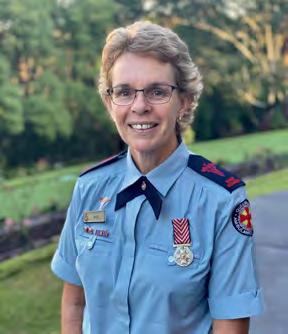



ASMs presented
Capalaba Critical Care Paramedic Sandra Cowley was recently presented with her ASM by the Honourable Paul de Jersey, Governor of Queensland, at Government House on 15 September.
Her proud family including her parents Carole and David and brother Steven were able to attend the ceremony to see her accept her medal.
Peter Solomon was presented with his medal on 22 September 2021 while his family watched on proudly.
And since our last edition, Childers Station ACP Gary Cotterill, Cleveland Station ACP Julie Calvert and Bowen Station ACP Gene Curtis have all been presented with their ASMs after being awarded on the Australia Day Honours List.
Top
■ Sandra Cowley with her parents Carol and David and brother Steven.
■ Julie Calvert.
■ Gary Cotterill.
■ Gene Curtis.
■ Peter Solomon with his Mum Carlene, partner Terese and son Nicholas.
to bottom, from left to right
19 Winter/Spring 2021 ASM Honours
Michael Formica receives national bravery award
Gayndah Paramedic Michael Formica was one of 11 people awarded Australian Bravery Decorations in August.
Michael received his Bravery Medal for acts of bravery in hazardous circumstances after he displayed considerable bravery during the rescue of people from a burning house in Harristown, Queensland on 10 September 2019.
His award was announced on 17 August and in the coming months he’ll be presented with his medal at a formal ceremony at Government House in Brisbane.
Michael was off duty visiting family in Harristown in September 2019 when he noticed a house on fire, and crawled through thick, black smoke several times to retrieve the distressed residents of the home.


“I just felt so relieved and thankful that the outcome for the residents of the house was all positive in regard to their health and wellbeing,” Michael said.

“I also feel very proud and humbled by the announcement of the award.
“In particular I’d like to thank those who were involved in submitting the application on my behalf – I did not expect to be recognised in this way.”
Michael Keal receives Distinguished Service Medal
In July the QAS Commissioner Russell Bowles presented Townsville Paramedic Michael Keal with a Distinguished Service Medal (DSM) for his actions in 2009, which epitomise the criteria of a courageous act.
On that day, a rescue helicopter was making its way to a container ship off Horn Island to provide medical assistance to an ill patient.
While the QAS officer Jamie Jackway and a member of the helicopter crew were being winched onto the container ship, the cable failed and both officers fell 10 metres onto the container ship. Tragically, Jamie’s multiple injuries rendered him a quadriplegic.
Michael was off shift but was recalled to duty to crew a second rescue helicopter to respond to the incident. He was winched onto the container ship in dangerous winds and treacherous seas where he quickly assessed, treated, and prepared the two injured officers for extraction onto the helicopter.
Once on board the helicopter and enroute to Thursday Island Hospital, Michael continued to provide medical treatment to the two injured officers.
Throughout this tragic incident, Officer Keal demonstrated his bravery, strength of character, professionalism, dedication and commitment to the QAS and to his fellow colleagues.
Awarded at the discretion of the Commissioner, the DSM is the most prestigious honour given to operational staff to recognise conspicuous service and humane and brave acts.
The presentation was made even more special by Jamie Jackway’s attendance, himself a DSM recipient.
Above
■ Michael Formica.
Above, top and bottom
■ Russell Bowles with Michael Keal and Jamie Jackway.
20 Winter/Spring 2021
■ Distinguished Service Medal.
Long Service awards
Since our last edition of Insight many QAS staff and volunteers have celebrated major milestones with the Service. Here are a few wonderful examples… September
Townsville Station’s Sharon O'Connor began as an Honorary Ambulance Officer in 1993 when she started working at Goondiwindi Station in 1995 before spending a couple of years as an Ambulance Officer and Paramedic in the Northern and Central regions at Ayr, Mackay, and Gladstone stations. In April 2000, Sharon moved into the role of Central Region's Communications Centre Supervisor and in 2006 she returned to the Northern region. She continued in the Townsville Operations Centre as an Emergency Medical Dispatcher, Professional Development Officer, and an Operations Centre Supervisor. Sharon has achieved so much in her quarter of a century with the QAS and we wish her the absolute best in her well-deserved retirement.

Our Townsville District awards ceremony saw 18 staff and volunteers receive medals, badges and certificates for a combined 300 years of service in the QAS. While we’re proud of every one of these hard-earned milestones, particular standouts in Townsville include paramedics Bernadette Carnes and Marko Isokangas who have reached an incredible 30 years of service. Michael Grainger and current acting Townsville Director Amanda Harper aren’t far behind as they received their National Medals for 25 years of service.

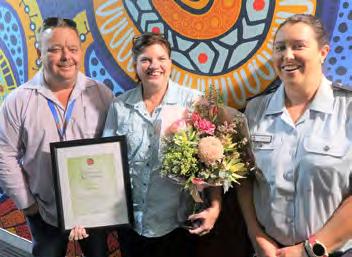
Kedron Park Paramedic Tracey Cater received her National Medal 1st clasp for 25 years of service from Deputy Commissioner Dee Taylor-Dutton at the Kedron Emergency Services Complex. Having spent most of those 25 years working in rural locations in Central Queensland, Tracey is now a valued team member in the Office of the Commissioner.
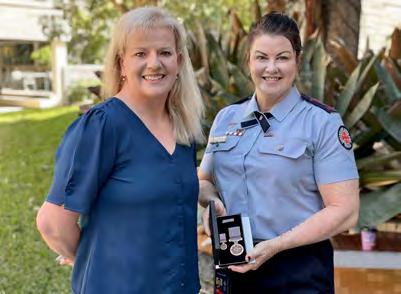
Kawana Station’s Officer Matthew Peterson was recognised for his 20 years. His colleagues and the rest of the QAS family wish Matt all the best as he begins his next chapter!
■ Matthew Peterson.
 ■ Sharon O’Connor.
Above
■ Townsville team.
In frame
■ Marko Isokangas and Bernadette Carnes.
■ Deputy Commissioner Dee Taylor-Dutton with Tracey Cater
■ Sharon O’Connor.
Above
■ Townsville team.
In frame
■ Marko Isokangas and Bernadette Carnes.
■ Deputy Commissioner Dee Taylor-Dutton with Tracey Cater
TURN OVER 21 Winter/Spring 2021 Long Service
Long Service awards
Central West District’s Executive Manager Gavin Farry was proud to present Doug Williams and Frank Standfast their QAS Committee Service Badges, recognising 25 years and 5 years respectively.

Millaa Millaa LAC congratulated Brigitte who clocked up two decades volunteering. Assistant Commissioner Michelle Baxter was pleased to present her with a 20-year Service Badge at the recent Annual General Meeting.

Woodgate LAC’s President Wendy and Workforce
Readiness Acting Manager Michael were pleased to present Margaret Featherstone, a cherished member of the Woodgate First Responder Group with a Certificate of Appreciation on her retirement.
■ Wendy, Margaret and Michael.


Gordonvale LAC’s Robert Murray was presented with his 20-year Service Badge from Northern Region Assistant Commissioner Michelle Baxter in August. Robert started as an honorary member of the QATB before joining the Gordonvale LAC in March 2000 where he is now president.
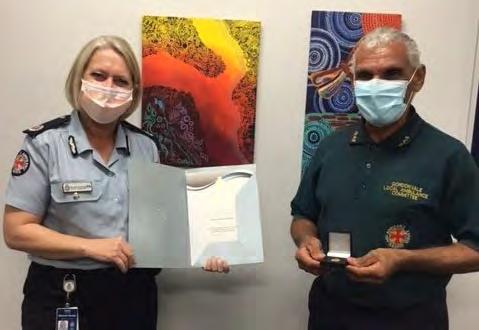
At Kedron Park Wendy Lowes was a Council of Ambulance Authorities 2021 Women In Ambulance Honour Recipient having served the Queensland Community with QAS for more than 30 years! Wendy originally started in the public service in 1990 as an Administration Officer (AO1) with the Queensland Ambulance Transport Brigade. Over the last 30 years, she has performed roles across all facets of HR, starting in payroll, recruitment, establishment management, providing HR advice and support to senior management, executives and staff. Wendy has successfully led and managed several high performing teams throughout career and was permanently appointed to the role of Director HR Services in 2018.

Left
■ Gavin Farry and Doug Williams. Right
■ Gavin Farry and Frank Standfast.
■ Michelle Baxter with Brigitte.
■ Michelle Baxter and Robert Murray.
■ Wendy Lowes.
July
August
22 Winter/Spring 2021
Central West celebrated Paramedics Doug Armstrong on 30 years of service and Ken Eyles for 10 years of service. LAC members Beth O’Neill reached 30 years volunteering and Tanya Forsyth 5 years.
A huge congratulations also to service stalwarts Doug Merchant and Ian Scott who both volunteered their time to the community dating back to the 70s.

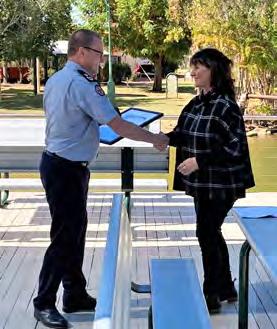
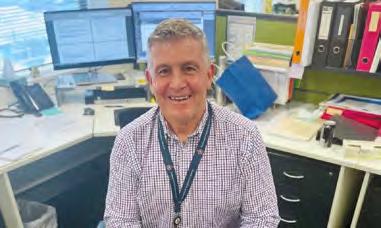
At Kedron Park it was a special knock off for one of our long-standing public servants. Gregory Hehir reached a colossal 30 years with the QAS in late June before retiring. First starting in our Central Queensland region and managing departments like business support, human resources and community education, Greg has left an indelible mark on our organisation.

■ Beth O’Neill
■ Ken Eyles
■ Doug Merchant and Ian
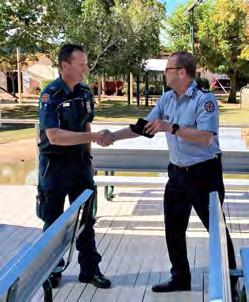

During this time, he also volunteered as a member of the Rockhampton LAC. Greg finished his career in our Metro North office and his colleagues presented him a Commissioner’s Certificate of Appreciation and a plaque to express appreciation for his valued service.


Winton Station’s Peter Ball was officially recognised for his mind-boggling 45 years of service with National Medal 2nd and 3rd Clasps and a QAS Long Service Medal 2nd Clasp. His dedication is greatly appreciated in the remote Central West Queensland town and his work mates Troy and Andrew couldn’t be prouder.
 ■ Peter Ball with colleagues Troy and Andrew.
Top to bottom
■ Doug Armstong with Russell Bowles.
■ Tanya Forsyth with Russell Bowles.
with Russell Bowles.
with Russell Bowles.
Scott.
■ Peter Ball with colleagues Troy and Andrew.
Top to bottom
■ Doug Armstong with Russell Bowles.
■ Tanya Forsyth with Russell Bowles.
with Russell Bowles.
with Russell Bowles.
Scott.
June 23 Winter/Spring 2021 Long Service
■ Gregory Hehir with Metro North colleagues.
Mick’s challenge to QAS –consider donating blood stem cells
Mackay paramedic Mick Lowth has been helping save lives for decades and he’s encouraging us all to join him.
Mick said 20 years ago, he signed up with the Australian Bone Marrow Donor Registry (ABMDR) while donating blood through the Australian Red Cross Life Blood. And he’s been donating blood and blood plasma intermittently ever since.
“About a year ago, I received a phone call from the ABMDR advising I may be a potential match for a patient needing a blood stem cell donation,” Mick said.
“I don’t know any of the patient’s details, other than they are an Australian adult cancer patient.”
Mick said the information he was provided with indicated the patient was most likely someone who had undergone treatment and was now in remission, but because of this treatment, they needed a stem cell donation to survive and recover.
“I jumped at the opportunity to help,” he said. “In the following months I had an initial telephone interview and blood test, and as the results were promising, I was flown to Brisbane for a full medical review at Royal Brisbane and Women’s Hospital.”
Before long, it was official – Mick was a match. Within a month, Mick and his wife, Lorraine returned to Brisbane to start his stem cell donation process.
“The whole experience was extremely well organised, with ABMDR
covering accommodation, transport and meals,” he said.

“From a few days before the blood stem cell donation I gave myself daily subcutaneous injections to bring the stem cells out of the bone marrow and into the peripheral blood circulation for harvesting.
“Once this was done, the stem cell collection itself was straightforward and pain free.”
A cannula was placed in both of Mick’s arms and his blood was cycled out of peripheral circulation, spun in a centrifuge to extract the stem cells, with his remaining blood returned through his other arm.
“In my case the collection was very successful indeed,” he said.
“The apheresis unit needed to collect 3 million cells, and we hoped to collect 5 million cells, but we ended up collecting 11 million.
“Sometimes being 197cm tall and weighing in at 120kg can be an advantage!”
Mick said he was pleased to report he had no side effects from the stem cell collection.
doubt been through a tremendous ordeal.”
Mick is keen to encourage more Queensland Ambulance staff and families to join the registry.
“Apart from it being another way of saving someone’s life, I’m also promoting the register because on my donation day, one of the coordinating nurses told me in all the years she’d been working in that field, I was the first paramedic donor she had met, but she had seen heaps of QFES members donating.
“In terms of friendly, respectful rivalry, I reckon we are being outdone by the firies and I think we could be doing something to change that.”
According to the ABMDR Donor Coordinator, Roina Doolan, every year more than 400 Australians receive blood stem cells from unrelated donors.
“Blood stem cell donations are used for people suffering leukaemia or other blood related diseases and these transplants are generally a last-resort option for these patients,” Roina said.
24 Winter/Spring 2021
■ On donation day… Mackay paramedic Mick Lowth holds two bags in hospital – a red bag containing his stem cells and a yellow bag of blood plasma.
“We currently have a registry of a little over 170,000 volunteer blood stem cell donors available to be matched with patients both within Australia and overseas.
“The chances of finding a match for patients in need depends on the characteristics of the donors,” she said.
“And to find the best possible match, patients need a donor from a similar ethnic background to their own.”
Roina said while 170,000 may seem like a lot of registered donors, there are still patients who remain unmatched, simply because the genetic markers used to match patient and donors are so varied.
“This is why we work so hard to recruit more donors to the registry,” she said.
“Mick is a blood/plasma donor. Many stem cell patients require blood/plasma products to treat their diseases prior to receiving stem cells, so we encourage any eligible donors to donate blood and join the ABMDR program if they are aged between 18-35 years old.
“These blood stem cell transplants aim to save the patient’s life and cure their diseases. The best chance of success is if the donor is ideally male and younger i.e. 18-35. Currently, less than 5 per cent of the 170,000 Australian donors on the Registry fit these characteristics.”
To find out more or to register to donate blood and/or stem cells, or to check your eligibility, call 13 14 95 or visit ABMDR Bone Marrow Donation | ABMDR or Australian Red Cross Lifeblood.
Casey is the next cab off the rank….
Coincidentally, Kedron-based Critical Care Paramedic Casey Lewis was scheduled to donate blood stem cells in September. He chats to us about his decision to donate…
Why and when did you decide to put your name on the bone marrow donor registry?
I don’t particularly remember why, but I have been donating blood and blood products pretty regularly since I was 18 and it was a check box on a form. I never really gave it much more thought.
Obviously since the registry called to inform me I was a partial match and we started going through the process and it was looking more likely, I have given it a lot more thought.
We all recognise that cancer “sucks”, and everyone knows someone who’s been impacted in various ways. I feel privileged really to be in a position where I can help in some small way.
When is your big day?
We hope to have our big day in late September.
How do you feel about it?
I was originally a little nervous, but the team I have been working with have been amazing and have provided a wealth of information.
The risks are really quite small, so in reality, I’m expecting I may (or may not) have a week of feeling a bit “off” on the medication provided and a day or two of dialysis which gives me the perfect opportunity to catch up on Netflix.
But the great thing is knowing someone else out there hopefully gets an opportunity for more years of life to live, vastly improved health and everything that comes with that. It’s easy maths.
What would you say to people considering putting their names on the registry?
Tick the box. Chances are you’ll never need to do anything more, and if you do end up being a match, you’ll be able to go through all the information and make a choice then.
While you can donate until you are 65, the best donors are under 35.
You must be 18 35 to first register your name. That means there’s a very small pool of eligible candidates out there, so if you’re eligible and are considering donating blood, or you’re a regular donor, please just tick that box as there is a real need and you can make a significant difference to someone’s life.
Can you ever find out anything about the person you’re donating to?
As Mick says, “Registration is easy, the stem-cell donation process was pain free, so why not join the ABMDR and help people in need”.
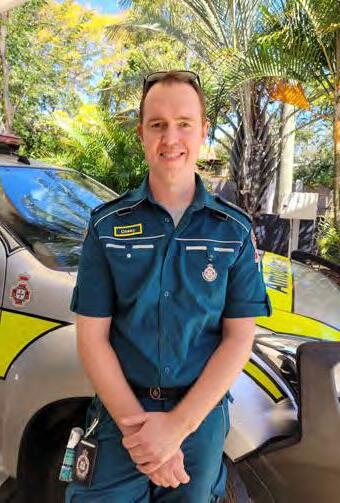
There is the possibility of finding out who you’re helping if both parties agree, and there’s also opportunities for donors to write a letter or card to the recipient, but that said, all arrangements are made to prioritise protecting both participants’ privacy. And honestly, after the last 18 months or so we’ve all had, part of me just likes the idea that we don’t need to know someone personally to care about them – this kind of sums up the attitude I see amongst my colleagues every day.
25 Winter/Spring 2021
■ Critical Care Paramedic Casey Lewis Stem Cell Donation Challenge
Warwick Pentathrun fundraisers for First Responder defibrillators
This year’s Warwick Pentathrun organisers presented five defibrillators to QAS’s Killarney First Responders in August.
The annual Warwick Pentathrun is a full weekend event held at the end of May comprising five footraces over varying terrain, covering a total of 42.2km (a marathon distance) and this year more than 300 runners descended on Warwick to compete.
The event has been held for several years with proceeds raised going back into the community.
Warwick Station’s Officer in Charge Wayne Kirk, said the Killarney First Responders service an area comprising approximately 1,300 people in the Southern Downs Regional Council.
“More than 50,000 people live in this broader region,” Wayne said.
“Our Killarney First Responders, who are situated just under half an hour away from Warwick, currently have four defibrillators,” he said.
“This enables them to each have one, thus kitting them out to be able to administer their full skill set to their community.
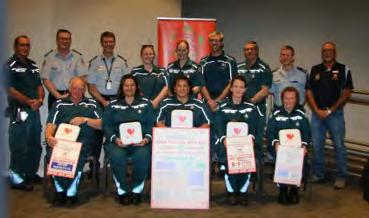
“The defibrillators are a much appreciated asset to the First Responders, as they continue to be a highly valuable link in the chain of patient survival.
“I’d also like to say a big thank you to the Warwick Local Ambulance Committee members for assisting the fundraising event by handing out much needed bottles of water to the thirsty competitors.
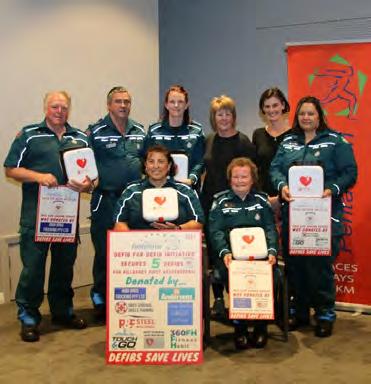
“We’ve had them since 2007 when the program first began and these defibrillators have been a great asset.
“These defibrillators have now come to the end of their life, and these five new defibrillators donated, are the latest AEDs and will provide the First Responders with around 15 years of service to the local community.
“To date this year, the Killarney First Responder group has attended some astounding 105 cases, and on average their response times are between 6 11 minutes – this is the time between when the Triple Zero (000) call is received and when the ambulance arrives on scene.
“We’re keen to have everyone in the community learning First Aid and CPR as while our First Responders do have Heartstart Defibrillators, it is also important for the community to learn to identify when a patient requires CPR and that they can confidently perform it so they can keep the patient viable until our First Responders arrive.
“This essential skill can have a significant impact on a patient’s future survival.
“I’d like in particular to acknowledge and thank one of the organisers, Jenny Thornton, whose passion and hard work has seen the delivery of more than 30 defibs to the Warwick Community.
“Jenny’s commitment to providing these lifesaving tools grew from the tragic loss of her husband to a cardiac event and her desire to provide others in the community with the tools to provide the best chance of survival in a cardiac event.
The presentation took place on Wednesday, 11 August in Warwick and was attended by many of the event volunteers and business houses as well as the recipients.
Left column
■ Driving force: Karen Gilchrist & Jenny Thornton with Killarney First Responders (L to R): Ray Bodley, Wayne Kirk (OIC Warwick Station), Anna Hamilton, Trish Wagner-Ross. Front: Jacqui Swift-Ross, Val Flint. Middle column
■ Left to Right: David Thompson, Steve Johns, Glen Maule, Jesica Cross, Lyndsey Brown, Paul McHardy, Wayne Kirk, Jamie Taylor, Paul Ryan. Front: Killarney First Responders. Right column
■ Warwick LAC: John Towells, Paul Ryan, Peter Stewart, Jack Barford, Barbara Reid with Warwick OIC and Killarney First Responders.

26 Winter/Spring 2021
QAS supports A-positive cause
Hundreds of QAS staff members rolled up their sleeves as part of the Emergency Services Blood Challenge, Madolyn Sushames writes.
Emergency Services across the country battled it out to see which one could make the most donations between 1 June to 31 August.
Team QAS donated more than 320 times –saving almost 1000 lives – and finished 15th on the leader board.
A big thank you to everyone who got involved and also to Kedron HQ paramedic Caitlin Denning and Dr Dan Bodnar who jumped back on the donation train for the photo opportunity, joining our QPS and QFES rivals last month at the Brisbane City Donation Centre in a national push to encourage more people to donate blood.
Because of COVID-19, Australian Red Cross Lifeblood has recorded mass cancellations across the country, but the need for blood doesn’t stop.
In fact, blood donation appointments need to double between now and Christmas to ensure our nation’s healthy blood supplies keep flowing.
Donating blood is an essential health service and the Australian Red Cross Lifeblood team is urging new and existing blood donors to book a donation now.
While Team QAS couldn’t beat our QPS or QFES counterparts, the real winners were all the families who received the gift of a plasma, platelets, or whole blood donation.
For more information about how you can donate blood go to Lifeblood.com.au
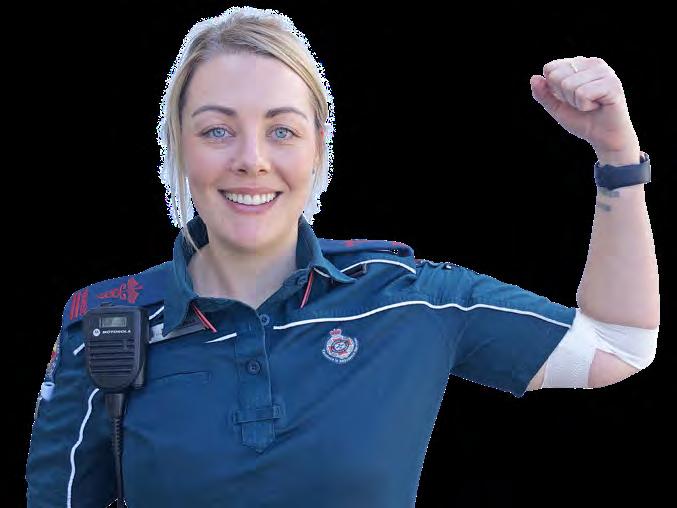
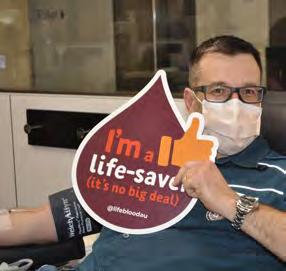


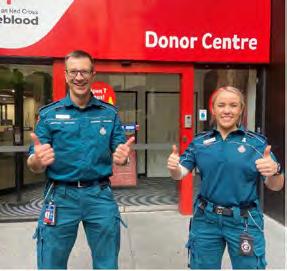
 Top to bottom, from left to right
■ Mikaela Ryan. ■ Dr Dan Bodnar. ■ Ryan McVeigh from Eatons Hill Station. ■ QPS and QAS challenge members. ■ Dr Dan Bodnar and Paramedic Caitlin Denning from Kedron Park. ■ Catherine Allen from Beenleigh station and Ebony Hewett from Southport Station.
Top to bottom, from left to right
■ Mikaela Ryan. ■ Dr Dan Bodnar. ■ Ryan McVeigh from Eatons Hill Station. ■ QPS and QAS challenge members. ■ Dr Dan Bodnar and Paramedic Caitlin Denning from Kedron Park. ■ Catherine Allen from Beenleigh station and Ebony Hewett from Southport Station.
27 Winter/Spring 2021 Blood donation challenge
Doctor’s ‘brilliant’ new first aid technique can stem blood loss after shark attack
Described by another expert as a ‘fantastic life‑saving idea’, the simple procedure could save lives by stopping catastrophic blood loss from shark bites. Original story by Royce Kurmelovs in The Guardian.
An emergency department doctor says he has developed a simple new way to help save the lives of shark attack victims in the crucial moments after a bite.
The technique is described in a paper published today in the journal of Emergency Medicine Australasia and works by closing off the femoral artery to prevent a person from rapidly bleeding out.
Applying the technique relies on a second person making a fist and pressing it into a person’s groin at the central point between the hip bone and the genitals.
From there they only need to lock their arm straight and use their bodyweight to apply pressure until blood flow from the wound stops.
Following these steps then buys the victim time while help can be sought.
Dr Nicholas Taylor, Associate Dean of the ANU Medical School, surfer and lead author on the study said he began to develop the idea after a family holiday to Western Australia at a time when there had been a spate of shark attacks.
“I was looking for a few ways to make myself a bit more shark proof,” he says. After speaking to surf life savers and surfers he found most would instinctually react to a shark bite wound by placing direct pressure on it or attempting to make a tourniquet from material they had on hand.
Dr Taylor said his emergency room training told him that this would be a mistake.
“A shark bite is a terrible sawing motion and putting pressure on it wouldn’t work,” he said. “And it would be great if every surfer carried a tourniquet, but it isn’t going to happen.”

Participants were given no prior training or instruction in how to apply the manoeuvre before attempting it, and the results were compared to the effects from using a makeshift tourniquet from surfboard leg rope.
Closing off the femoral artery stopped all blood flow to the leg in three out of four participants while using the tourniquet reduced blood flow by 43.8 per cent.


A better solution, he thought, would be to cut the blood flow from the femoral artery as taught in medical schools and performed in emergency departments.
To test the effectiveness of the technique, Dr Taylor helped organise a study of 34 healthy volunteers. While the sample size was small, it was more than double the 16 participants a pilot study recommended was required for it to be statistically significant.
An ultrasound was used to gauge the rate of blood flow through the artery and into the limb.
The researchers also tested whether a wetsuit might make it more difficult but found it made no difference.
Now Dr Taylor says he wants to see the technique incorporated into first aid training – and to help he has developed a mnemonic for remembering the process: “push hard between the hip and the bits”.
However, for that to happen it would first need to be endorsed by the Australian Resuscitation Council and incorporated into their guidelines for managing bleeding wounds.
Dr Anthony Brown, a professor of emergency medicine at the University of Queensland who was not involved in the study said the novel approach was “brilliant” and should be considered for inclusion in first aid training programs, particularly for surf life saving and the surfing community at large.
“It’s a fantastic life saving idea. Nothing else helps,” Dr Brown said. “By the time you need to give mouth to mouth or CPR during a shark attack, it’s too late. It means the person has exsanguinated [drained of blood].”
Compared to applying pressure on the wound itself, Dr Brown said that this technique would be more effective as it would avoid potentially re opening arteries that may have closed off by spasm.
“Your sole priority needs to be to stop the bleeding and wait for help,” he said. “You’re a bit buggered if you’re the only one there, but generally speaking there is someone else there to help.
Nobody surfs alone.”
28 Winter/Spring 2021
■ Images from The Guardian article here.
Townsville mental health help heads home for patients
Queensland’s frontline response combating the state’s mental health crisis gained new ground in July with the launch of a specialist team in Townsville, Matt Stirling writes.

Townsville’s QAS Mental Health Co-responder Program which launched at Kirwan Ambulance Station in July, is the latest to pair paramedics with mental health clinicians to provide timely and more tailored care to patients experiencing a mental health crisis.
This program recognises first responders’ unique position to determine the course and outcome of a patient’s mental health crisis and has proven to be highly successful since its 2019 South East Queensland trial (including Metro South, Metro North, and the Gold Coast).
This year the program received dedicated funding and was officially launched at the Sunshine Coast and Cairns, and now, Townsville.
Kirwan OIC Sandie Gawn said Townsville’s team hit the “green light” on 26 July when the station welcomed three senior mental health clinicians from Townsville Hospital and Health Service (HHS), who donned teal uniforms for the first time.
The paramedic/clinician partners have been operating daily since then from midday to 10pm, covering the mental health callout peak periods.
“This launch is timely, considering over the last three years mental
health-related Triple Zero (000) calls have increased by 20 per cent across the state,” Sandie said.

“In its first three weeks operating in Townsville, our team provided early assessment and support to 70 people experiencing a mental health crisis in the safety of their own home –something which would otherwise only have happened in an emergency department’s busy and clinical environment.
“The positive feedback we’re already receiving highlights the real benefits behind referring suitable mental health patients away from stressful emergency departments,” Sandie said.
“While the community is still learning about these new services, we are starting to see patients call and request a mental health co-responder team – and that’s wonderful.”
Townsville emerged from its first lockdown in early July and QAS Mental Health Response Program Director Sandra Garner said many people are experiencing depression or anxiety symptoms for the first time as the ongoing impacts to employment and living arrangements are being felt across the state.
“This is the first time we’ve had mental health clinicians who can provide education and an understanding of what’s happening to a person experiencing a mental health crisis,” Sandra said.
“The timeliness and types of intervention provided have a significant impact on the speed of a patient’s recovery journey.
“The team’s ability to undertake a mental state examination and then tailor a risk management plan alongside a QAS physical assessment resulted in 63 per cent of these cases avoiding hospitalisation altogether.
“These results are in line with other regions in the state, with patients referred to more appropriate recovery pathways and follow-up interventions in a more holistic approach to care,” Sandra said.
Top ■ Townsville HHS senior mental health clinicians Kate De Vreeze, Kelly Thompson and David Kirk (centre) were welcomed by QAS Kirwan staff Adrienne Pugnale and Bernadette Carnes (outside).
Inset
■ Senior mental health clinician Kate De Vreeze spoke to local media on the benefits of the program.
29 Winter/Spring 2021 Mental Health Co responder Program update
QAS marks Reconciliation Week and celebrates NAIDOC Week
This year’s theme for Reconciliation Week (27 May – 3 June) was “More than a word. Reconciliation takes action” providing QAS with the perfect opportunity to mark the occasion by recognising National Sorry Day, the significance of the 1967 referendum and Mabo Day.
The QAS Commissioner Russell Bowles embraced the theme “More than a word. Reconciliation takes action” and acknowledged the ongoing achievements of the QAS Indigenous Network, the success of our QAS Indigenous Paramedic Program cadets and the QAS Indigenous School Based Scholarship Program.
COVID-19 lockdowns in South East Queensland disrupted some of QAS’ NAIDOC Week plans but stations outside the locked-down areas were able to mark the week in style (as you’ll see from the photos supplied!).
NAIDOC Week is recognised from the first Sunday of July each year and celebrates the history, culture and achievements of Aboriginal and Torres Strait Islander people.
The 2021 NAIDOC Week theme was “Heal Country”. Aboriginal and Torres Strait Islander people are connected both spiritually and culturally to this Country. Their adaptation, alongside an intimate connect to Country, has enabled our Aboriginal and Torres Strait Islander people to endure and survive for thousands of generations.
QAS staff outside the locked-down Local Government Areas were encouraged to connect with their local community organisations and where possible, represent QAS at events.
At Kedron Park headquarters, Russell and QFES Commissioner Greg Leach along with around 40 sociallydistanced staff attended a Flag Raising Ceremony to mark NAIDOC Week.
Additionally, QAS staff were encouraged to wear florals on Friday 9 July as part of a fundraising partnership with Queensland Aboriginal and Torres Strait Islander Foundation (QATSIF) to celebrate Torres Strait Islander Cultures during NAIDOC Week and to support our school-based scholarship initiative.
QATSIF is a not-for-profit trust managed by The Public Trustee with a focus on supporting Aboriginal and Torres Strait Islander children to complete high school and gain a brighter future.
QAS as a whole raised $425 for the Floral Friday Fundraiser – an amazing display of generosity from our Kedron staff and a great outcome for the Service.
NAIDOC Week also saw the unveiling of the QAS commissioned artwork “Caring for our Mob”, a collaboration between the QAS Indigenous Network and Carbon Creative, an external Indigenous creative design agency.
This is a significant milestone for the QAS and another important step on our journey to building cultural capability as an organisation and working towards providing culturally safe healthcare as a key initiative of the QAS Cultural Capability Action Plan 2019 – 2022.

The original “Caring for our Mob” artwork is available on the portal.
NAIDOC Week
“Caring for our Mob” represents the connection between the QAS and the Aboriginal and Torres Strait Islander community and each of the elements within the Indigenous Artwork has specific meaning.
At the centre of the design, traditional and modern health, as well as values of respect and inclusion merge to create a “healing pathway”, representing the journey to better healthcare.
The healing pathway is accessible and moves through the diverse communities, sharing knowledge and caring for Aboriginal and Torres Strait Islanders.
The original “Caring for our Mob” artwork is available on the portal.
Stay tuned for more exciting updates surrounding the QAS Aboriginal and Torres Strait Islander Cultural Safety initiatives!
When creating ‘Care for Country’ kept in mind that this meant spiritually, physically, emotionally, socially and culturally – chose to create bright and vibrant artwork that included the different colours the land but showed how they come together our beautiful country and to make people feel hopeful for the future. I’ve included communities/people, animals and bush medicines spread over different landscapes of red dirt, green grass, bush land and coastal areas to tell the story of the many ways country can and has healed us throughout our lives and journeys. by Maggie-Jean Douglas (Gubbi Gubbi) #NAIDOC2021 #HealCountry 4-11 JULY 2021
30 Winter/Spring 2021
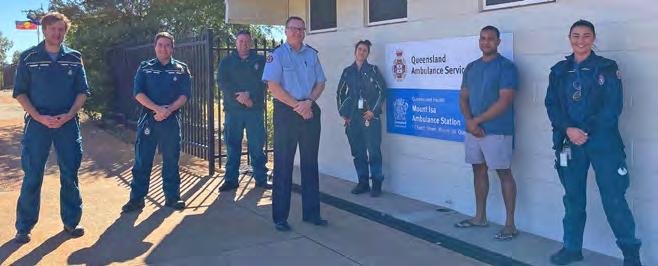
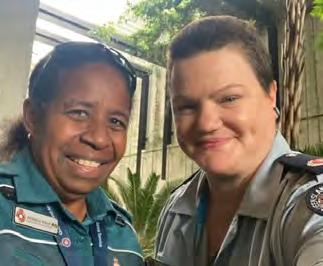


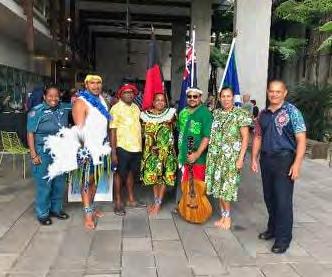



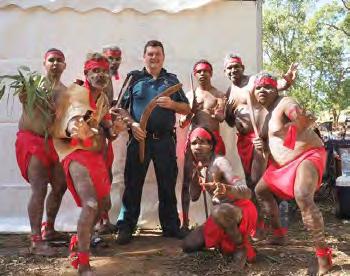

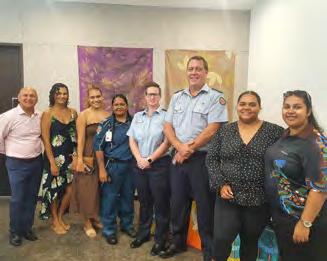

Winter/Spring 2021 31 Celebrating NAIDOC Week 2021
QAS Torres Strait Islander Paramedic George Fennemore clocks up 30 years
One of QAS’s longest serving Torres Strait Islander staff members
George Fennemore said he chose to be a paramedic not only because it provided him with a job with a career path, but it also enabled him to be a role model in his community.
The Edmonton Ambulance Station Advanced Care Paramedic is being presented with his 30 Year Long Service Medal this year.
He’s the only Torres Strait Island man in Cairns and is one of the longest serving Torres Strait Islander paramedics in the Service (Deidree Whap has a few weeks on him). George plays a key mentoring role for Aboriginal and Torres Strait Islander cadet paramedics.
“There have been heaps of changes while I’ve been working with the Service,” George said.
“From when I started as a cadet in 1988 in the Torres Strait Islands, when we were still the QATB and beyond our transition to QAS, there have been so many changes over the years, from our equipment, protocol, systems, people, vehicles – you name it!”
Originally from Darnley Island, George blazed his own trail in the Service.
“As a student paramedic one of my very first jobs was responding to Tjandamurra (Jandamarra) O’Shane,” George said.
For those who may not remember this case, the Cairns community (and the rest of Australia) was rocked in 1996 when six year old Aboriginal boy Jandamarra was doused with petrol and set alight in a random playground attack. He wasn’t expected to survive the horrendous burns to 70 per cent of his body.
“It was a very confronting and emotional experience as we saw a young Aboriginal boy in incredible pain, trying to make sense of why he was attacked and at the
same time crying out for his mum while his skin was blistering and peeling off.
“On reflection, I am pleased I was there for him given our similar cultural backgrounds.
“I had kids around his age, and I think my cultural background would have given him some small comfort while we worked on him,” he said.
“I think it also certainly reinforced the need for us as a Service to be able to provide people with a feeling of cultural understanding and safety.”

George spent 19 years in the Service as a solo operator out in a rural and remote station west of Mackay which he said also had a significant influence on his career.
“Out there when you’re on your own, you had to do a lot of thinking outside the box – especially when you’re working with badly injured patients preparing them for the rescue chopper,” he said.
When he started his career in the Service, George said he encountered a lot of obstacles, with racism being the largest of them.
When this happened, George said he would instead focus on the help he could provide to people who were sick or in pain.
“So many people would take a look at me and pre judge me and guess my ability,” George said.
“But when I’d get them to hospital – I had the satisfaction of getting it right for them and perhaps proving them wrong.
“I just hope it will make them think again next time when someone else of colour comes to them,” he said.
George’s work also importantly provides cultural safety and sensitivity to many of his patients.
“If we go into a house and I was with a non Indigenous paramedic providing patient care, Aboriginal and Torres Strait Islander patients would look to me and I could put it into creole and language and they could give me the correct information we need,” George said.
“People can be a bit shy and withdrawn but they open up to me when they see my colour.”
Despite his imposing frame (he’s close to six foot tall), George describes himself as a gentle giant.
“I always had a caring nature and a big heart for people – you wouldn’t be in the job unless you did,” he said
And what would George say to our early career Aboriginal and Torres Strait Islander staff?
“Stick with it and if you love helping people, it’s in your heart – follow your heart and before you know it, 30 years or more have passed,” he said.
Above
■ George Fennemore.
32 Winter/Spring 2021
NAIDOC Week
(4-11 July 2021)
Priority One would like to acknowledge the Traditional Owners and Custodians of the land on which we work and gather. We pay tribute to Australian Aboriginal and Torres Strait Islander Elders, past, present, and future, attributing great respect to their knowledge, wisdom, and custodianship.
This year’s theme for NAIDOC Week was “Heal Country”, and Priority One would like to express our gratitude for the support Priority One Aboriginal and Torres Strait Islander Peer Support Officers (PSOs) provide to all who engage with them.
A message from Priority One and the Aboriginal and Torres Strait Islander Peer Support Group
These PSOs proudly identify as an Aboriginal and / or Torres Strait Islander person. The group started in 2001 as a group of three and now 20 years later, we have 11 Aboriginal and Torres Strait Islander PSOs.
All our PSOs, including our Aboriginal and Torres Strait Islander group, are trained QAS volunteers who have been selected to support their peers. They are QAS staff who undertake a selection process and training to voluntarily support their peers. While they provide the same level of support, respect and confidentiality to QAS staff as the other PSOs, they also bring with them the lived
experience and cultural understanding to best support our Aboriginal and Torres Strait Islander staff and their dependent family members in a culturally safe way.
Our Aboriginal and Torres Strait Islander PSOs’ names and contact details can be found on the QAS Portal under Priority One and on the PSO contact lists You can find this symbol next to their name.

Two of our very first Aboriginal and Torres Strait Islander PSOs, Peter Heron and Deidree Whap have shared a few words on what ‘Healing Country’ means to them…
Peter’s message
Healing Country to me, means the healing of our mob. The healing that is required for the Stolen Generation comes to mind.
Then there’s the healing of deaths in custody victims and their families, also domestic violence that is rampant through the Indigenous communities.

Healing also means restoring our identity and culture, back to warriors, Custodians, and story tellers, because the non-Indigenous view of us is of alcoholics, dole-bludgers who beat our women.
I also believe healing starts with the family, then the community and then country.
Governments of the day can write policies and deliver programs around ‘healing’, but I believe without the investment from the grass roots up, we have no platform to work from.
Deidree’s message
This is my understanding of how healing is to me, QAS and community.
Healing to me is firstly about accepting my natural state of wholeness, wellbeing, one with my mind, body and soul, regaining, restoring one’s self mentally, emotionally and socially after imbalance, injury or disease.

For our community and country, it is a big process as a group to try to gain trust, to build from what has been damaged, to physically rebuild, move on and develop as one.
QAS and Priority One are grateful and honoured to have the wisdom, knowledge and role modelling our Aboriginal and Torres Strait Islander PSOs offer and for the wonderful support work they do caring for Indigenous and non-Indigenous staff.
33 Winter/Spring 2021 Priority One
LGBTIQ+ Peer Support Priority One
Supporting, acknowledging, and celebrating the wide diversity of sexual orientation and gender identity of people within the QAS
Cassie Taylor, Critical Care Paramedic, Wide Bay District
In 1999 two brave young QAS staff members approached Priority One seeking help to establish the then Gay and Lesbian Support Network within the QAS.
This was the start of opportunities for the QAS and Priority One to make significant contributions in addressing issues faced by Gay and Lesbian ambulance personnel within and outside of their work environment.
The original purpose of the Gay and Lesbian Network as a component of Priority One included raising awareness of Gay and Lesbian issues within the Service and to encourage an environment that is free from homophobia.
Today there are 18 identified Peer Support Officers (PSOs) who are members of the Lesbian, Gay, Bisexual, Trans and gender diverse, Intersex, Queer and questioning (LGBTIQ+) PSO group.
As well as bringing with them their own lived experiences, LGBTIQ+ PSOs have all undertaken the usual Peer Support training and offer confidential support to their QAS colleagues around any difficulties they are experiencing related to LGBTIQ+ issues for themselves or their family members.
Names and contact details of our LGBTIQ+ PSOs can be found on the QAS Portal under Priority One and on the PSO contact lists. They are identified by this symbol next to their name. An LGBTIQ+ PSO can also be contacted by calling 07 3830 5888 and leaving a message with your call back number.
Two of our LGBTIQ+ PSOs, Cassie Taylor and Andrew Wheatland share a bit about who they are and their future hopes for LGBTIQ+ inclusion within the QAS.
I’ve been with the QAS for 11.5 years now in a mix of metro, regional and rural areas and am currently working in Hervey Bay as a Critical Care Paramedic. Outside work I enjoy keeping fit through long distance triathlons and like to get my money’s worth by being in the back of the pack. I also love snowboarding and am currently having snow withdrawals due to the COVID 19 pandemic. I am in a same sex relationship with my partner of six and a half years who puts up with my childish obsession with dinosaurs and sharks.
Tell us about your job
I am incredibly proud to have reached the level of Critical Care Paramedic in 2018 and feel honoured to be invited into strangers’ houses daily, sometimes in what is a life changing situation for them. I also have a strong interest in leading by example and empowering my colleagues to work to their full potential. I firmly believe there is no “I” in team and everyone contributes to patient outcomes.
What does ‘inclusivity’ mean to you?
Inclusivity to me means everyone is heard, valued, and seen regardless of their gender/sexuality/personal beliefs, etc. No one should be de valued because of who they are.
Why are you a member of LGBTIQ+ Peer Support?
Starting in QAS as a young graduate in a country town, there were very few LGBTIQ+ identifying officers “in the village” so to speak. I had no idea if it was “safe” to be open about my sexuality and I didn’t even know if QAS supported such diversity. I had only been “out” for a couple of years within my social circles and here I was trying to navigate a professional environment almost 1000kms away from home in a town full of miners and rodeos. I am pleased to say I managed
to successfully navigate the start of my professional career without having to hide my sexuality. The situation of having my own lived experience of uncertainty around being open about my sexuality in my workplace led to me wanting to be able to offer support and advice to staff within the LGBTIQ+ community. This support could be for a young colleague coming out, or for someone facing homophobia in the workplace who prefers to seek support from another LGBTIQ+ colleague who may better understand the situation. I also feel it is important to offer support to staff who are not a part of the LGBTIQ+ community but may be looking for support and advice around matters relating to LGBTIQ+ staff or if their own children or family members come out as being LGBTIQ+.
What would you like to see happen to support LGBTIQ+ inclusion within the QAS?
I would love to see more education for all staff around the use of pronouns, as well as education around transgender matters. I feel many staff are hesitant and scared about how to communicate with transgender patients due to a lack of understanding and being scared about asking the “wrong” question.
I would also like to see QAS make LGBTIQ+ patients aware that QAS is a “safe space” for them through the use of subtle indicators such as a rainbow flag option on name tags, a rainbow flag inside the back door of ambulances, use of rainbow lanyards, etc, as well as through their continued public support of LGBTIQ+ milestones such as Mardi Gras, Pride and IDAHOBIT day.
Opposite, top
■ Cassie Taylor.
Opposite, bottom
■ Andrew Wheatland.
34 Winter/Spring 2021
Andrew Wheatland, Emergency Medical Dispatcher, Cairns Operations Centre
I’m an EMD in Cairns Operations Centre. I love my motorbike, my bicycle and my hiking boots. All of these ensure a good workout in the beautiful surrounds of Cairns. I have always tried to support local LGBT+ organisations with volunteer work, including working with Cairns Tropical Pride, Joy 94.9 in Melbourne and Coast FM in Cairns, which led me to my career as an EMD. I identify as a cisgendered gay man, with a heart for our trans community, who I like to call my brothers and sisters. People often ask me why I make a point of saying my pronouns are He/ Him and identifying as cisgendered. Cisgendered just means that my gender identity aligns with my gender assigned at birth.
Tell us about your job
I came to ambulance communications from another career when I was new to the Cairns area. I have been with the Cairns Operations Centre for nearly eight years now. Answering the call for help and organising our response brings challenges and excitement to my daily work. There’s nothing quite like answering the call and knowing you can empower someone to get through their moment of need, no matter what is happening on the other end of the line. Of course, this wouldn’t be possible without the amazing supportive team we have at QAS.
What does ‘inclusivity’ mean to you?
Inclusivity is about eliminating intolerance and making sure that everyone feels safe. It’s more than that. It’s about seeing each of us as individuals and striving for equitable access for everyone. It’s about removing barriers that exist for everyone and removing barriers that exist for only smaller groups of people.
Inclusivity means celebrating the differences that exist between us as much as the commonality we share.
Inclusivity is a work in progress and something that everyone needs to constantly work at. I know I don’t get it right all the time, and I probably will miss the mark more often than not, but I must try. The first step is listening, really listening, to those around you whose voices aren’t loud.
Why are you a member of LGBTIQ+ Peer Support?
Growing up, I didn’t know anyone who was gay, I didn’t have anyone to look to, and I didn’t know of any safe places to talk about what was happening to me as I grew into the man I am today. I discovered myself when I could see and talk to other people who had been on this road before me. Just seeing men around me who were glad to tell me about the weekend they spent with their boyfriend made me feel somehow OK with how I was.
I believe we all have a responsibility to bring our whole selves to every part of our lives we never know who’s watching, or who needs to hear their story normalised by others. I am grateful for the people in my life who brought their whole self to my workplace.
Being part of the Peer Support program offers a practical way for me to help others, like how I was helped when I was younger.
What would you like to see happen to support LGBTIQ+ inclusion within the QAS?
Gay and Lesbian orientations are generally well understood in the wider community and within QAS. I have been well accepted within QAS and feel understood for who I am. I have always felt that there’s poor understanding of the delineation between sexual orientation, gender expression and gender identity. This is a problem that’s within the wider community too, not just QAS.

I found an interesting model that really gave me some language around gender and orientation, and I would love to see more people exploring it. The model is called the gender unicorn. Although I am not keen on the name, it does provide a framework and some language to use around issues of gender, gender expression and orientation. If you’re curious, there’s a summary here
I love that QAS is supportive of events like Pride Festivals and Wear it Purple day. We need to keep this up. I would love to see a time when our people from all parts of the Service are involved in celebrating significant days for the diverse communities we all participate in outside of work.

35 Winter/Spring 2021 Priority One

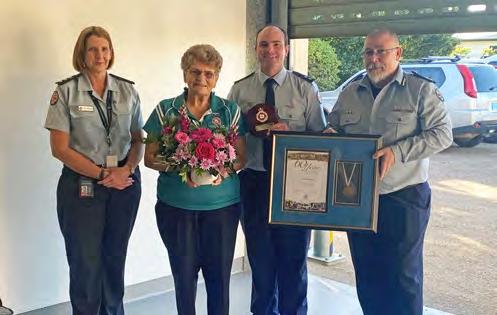



Carmel celebrates 60 years of community work for QAS
The prospect of anyone these days volunteering for 60 years is rare, but Queensland Ambulance Service has struck gold with Calen Local Ambulance Committee (LAC) member Carmel Wheeler.
The QAS presented Mrs Wheeler with a medallion, and other mementos on 25 August to thank her for her many years of service, as the day also marked her “final” retirement as LAC President.
The powerhouse grandmother of 24 and great grandmother of 19, has been behind much of the LAC’s fundraising over the years, including organising events like the Calen Local Ambulance Fair and the much loved Monster Cent Sale.
Mrs Wheeler has been an integral member of the Calen LAC since 1961 and was President from 1978 1982, 1988 1996 and more recently from around 2015 until this year.
“I made a comeback recently when no one else would take the role on, as I didn’t want to see the local group closed down, but this time it’s definitely final – I’m off to the backbench in the committee!” she said.
Mrs Wheeler made the commitment to raise funds for the then Queensland Ambulance Transport Brigade after a drama filled trip to hospital in 1957 when the ambulance she was in rolled.
She stayed true to this promise and joined Calen’s Benefit Committee in 1961 and started raising vital funds for the Service. A decade in Gympie from 1965 saw the LAC benefit there, before her family’s return home to Calen and its LAC.
Calen LAC’s secretary Marlene Senini said Carmel’s energy would be missed.
“From the short time I have been in the LAC, I can say Carmel has always worked tirelessly behind the scenes ensuring everything has been done for our fundraisers,” said Marlene.
“Carmel always advocates for the Calen LAC and the other community organisations she has been involved with and if volunteers are required, Carmel always manages to round up help.”
Carmel’s daughter Vicki Durnsford said her mother’s passion for the Calen LAC “was unbelievable”.
“Mum has always been proud to say without the support of her committee, the local community and our wonderful paramedics, our centre would not be the centre it is today,” Vicki said.
“To all Calen LAC members and helpers past and present Carmel would like to thank you all for your support and friendship over the past 60 years and please continue to support the new President and committee.”
Mackay District Acting Director Tracey Eastwick said she got to know Carmel as a new Officer in Charge (OIC) and a young paramedic when she was appointed as Calen OIC in 2007.
“I was young at the time I took the role of Calen OIC, and I didn’t truly understand or appreciate the dedication that has now spanned six decades of commitment to our Service, for which we are very privileged to have had,” Tracey said.
“What I did see early on was Carmel’s passion and drive for her role and the Service, she was fearless and bold as a courageous woman through the decades where this has had it barriers, and her wealth of experience and knowledge about the Service and community.
“It also didn’t take me long to recognise Carmel’s ability to bring people together and achieve outcomes consistently year after year and this deserves recognition and acknowledgement.”
Left From Carmel’s 60th service presentation (from l-r): Mackay District Acting Director Tracey Eastwick, Carmel, OIC Mark Petrie and Central Region Assistant Commissioner Robbie Medlin.
Right
36 Winter/Spring 2021
The big group one (from l-r): Counsellor Laurence Bonaventura, Tracey Eastwick, OIC Mark Petrie, the Calen LAC team, then Central Region Assistant Commissioner Robbie Medlin and Mackay Regional Council Mayor Greg Williamson.

Millaa Millaa couple retires after almost 100 years of combined QAS volunteering
A lot can change in 50 years – but Kevin and Dot Stinson’s commitment to their community has never wavered, Madolyn Sushames writes.
They joined the Millaa Millaa Local Ambulance Committee (LAC) in 1995 and after nearly 100 years of combined service between them, the long standing President and Secretary duo have announced their retirement.
Minutes show Dot’s involvement in the Queensland Ambulance Transport Brigade’s (QATB) Ladies Benefit Committee dates back to March 1970.
“The ladies sent out a letter wanting people to go on the committee, so I joined,” Dot said.
With some first aid experience from volunteering with the local Scout group, she soon led the group until it disbanded in 1983, so Dot then worked from the QATB’s Men’s Committee, but wasn’t considered a member –a sign of the times allowing women to volunteer but not become full members.
Dot was an Honorary Ambulance Officer at the Millaa Millaa Centre for almost 10 years until 1995, before becoming LAC secretary.
Then Dot convinced Kevin to join in 1988, making it a family affair.
“He joined because I talked him into it, I’m a little bit of a bossy boots,” she laughed. “One of our daughters joined the Committee as well for a few years before she moved away.”
Kevin was a QATB Committee Member from 1988 until the LAC was formed in 1991. He became Vice President from 1995, then Acting President/Chairman in 1999 and finally, he’s been the President/Chairman since 2001.




Their daughter Wendy Tenuissen will be taking on the President’s role and Carole Nucifora will be Secretary.
“We think they can’t manage without us but somehow or other, they do,” Dot joked.
“I think we do things like this in our community, not because we’re obliged to, but because we’re quite happy helping and raising money to go towards something for the community – it gives you a good feeling when that happens.
“But I know that it’s time to stop.”
In between dedicating their time to volunteering, the Stinsons took their six daughters caravanning around Australia on an unforgettable trip.
Now in their 80s, it’s time for their own adventure into retirement.
Far Northern Region Assistant Commissioner Michelle Baxter said the Stinson family had already made a huge contribution to the Milla Milla LAC and it was good to see their daughter Wendy continue their involvement.
“Volunteers like this are hard to come by and QAS would like to thank Dot and Kevin Stinson for all they’ve done for their community and the Service. We wish them all the best in their retirement.”
Left
Kevin and Dot Stinson. Right
Kevin and Dot in action fundraising in Millaa Millaa.
37 Winter/Spring 2021 Inside the Local Ambulance Committees
Celebrating 30 years as QAS (Part 2)

While QAS’s Local Ambulance Committee (LAC) Conference honouring our 30th Anniversary may have been postponed until mid next year, QAS Heritage and History Manager Mick Davis’ second instalment celebrating our 30 years as QAS has arrived! It recounts our second decade – A decade of transition – 2001-2011. (The first instalment published in our last edition can be found here.)
38 Winter/Spring 2021
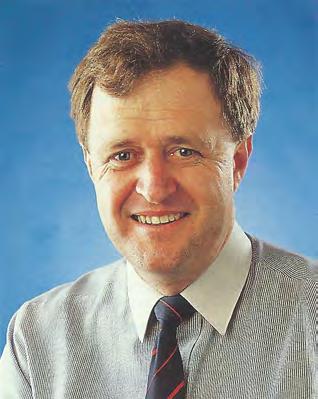

A decade after Queensland Ambulance Transport Bureau (QATB) transitioned to Queensland Ambulance Service (QAS), we found ourselves in an ambulance service quickly matching the better services in Australasia and being part of a greater service committed to continuous improvement. By the end of this second decade, QAS was considered among the better ambulance services across the globe.
During this time, four different Commissioners led QAS, with Dr Gerry Fitzgerald followed by Jim Higgins ASM, David Melville APM and, at the end of the decade, newly appointed QAS Commissioner Russell Bowles ASM.
Collectively, their leadership saw significant change across the Service including in clinical practice, ambulance education and training, pharmacology, operations, fleet, uniforms, industrial relations, gender equity, staff support and facilities all with the support of the state governments of the time.
The two QAS Medical Directors during this time, Dr Richard Bonham and Dr Stephen Rashford, were integral to these improvements and brought with them patient-focused care and acute clinical foresight.
The most visible change this decade was the new ambulance livery (vehicle colours and presentation) and the new teal ambulance uniforms, representing the international emergency health green shades. The QAS Logo was modified to include teal around the border.
Systems were introduced to monitor and maintain the officers’ clinical currency, as well as vehicle and equipment currency.
In this decade, basic QAS paramedic qualifications went from diploma to degree. With the introduction of equal opportunity in employment, our female officer contingent increased significantly, as did our Aboriginal and Torres Strait Islander paramedics.
In 2002 a paramedic wearing a navy jumpsuit with reflective strips would have administered morphine and midazolam to a QAS patient in pain. In 2010, a paramedic in teal might have administered ketamine, propofol and or “ketofol” for pain.
By 2009, a patient suffering a cardiac arrest had a much better chance of making a full recovery thanks to the new Coronary Reperfusion Strategy. QAS was the first Australian service to launch this strategy in February 2008.

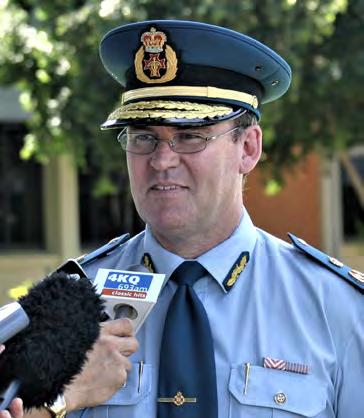
Opposite ■ Mick Davis. Top left and right ■ QAS Commissioner Dr Gerry Fitzgerald ■ Gerry FitzGerald & 1st Grp BA Health Science Middle
QAS Commissioner David Melville Bottom ■ QAS Commissioner Jim Higgins ASM 39 Winter/Spring 2021 Celebrating 30 years as QAS
■
This program involved Intensive Care Paramedics’ (ICP) early recognition of heart attack in the field. They could then either rapidly transfer the patient to a major cardiac centre or administer clot busting drug Tenectaplase at the scene. This meant patients would receive the drug around 30 minutes sooner than they would after arriving at hospital, and this greatly reduced their risk of permanent heart damage and greatly improved their chance of full recovery.

These, and other clinical practice advances during the decade became more readily accepted with greater training and education in QAS.
In the early 2000s a Diploma was the base paramedic qualification and was attained in-service after being employed. By the end of the decade, QAS was employing university qualified paramedics with a degree in paramedic science.
In 2007, Queensland University of Technology (QUT) had its first intake of QAS staff wanting to upgrade their qualifications to a Bachelor of Health Science (Emergency Health Services). QAS funded up to 30 officers to complete this degree through the Study and Research Assistance Scheme (SARAS).
It later became mandatory for paramedics to have a bachelor’s degree qualification indicating higher studies e.g. Graduate Diploma in Intensive Care Paramedic Practice. There were also a significant number of ‘graduates’ from Queensland and other states recruited between 2008-2012.
Other education and training developments from 1998 to 2003, set the basis for a degree qualification and paved the way for new staff training and development programs such as the Graduate Diploma, a Communications course, a Management Continuing Education Program (MCEP), Drug and Alcohol Testing in the Workplace, and a Baby Capsule Training Program for the Queensland community.
Ambulance Field Officers were trained and employed at Kowanyama and Horn Island as part of the Indigenous Service Delivery Enhancement package, and five “Indigenous Australians” were trained as Patient Transport Officers in Beenleigh and Brisbane, beginning a development program that has significantly increased representation of First Australians in QAS ranks.

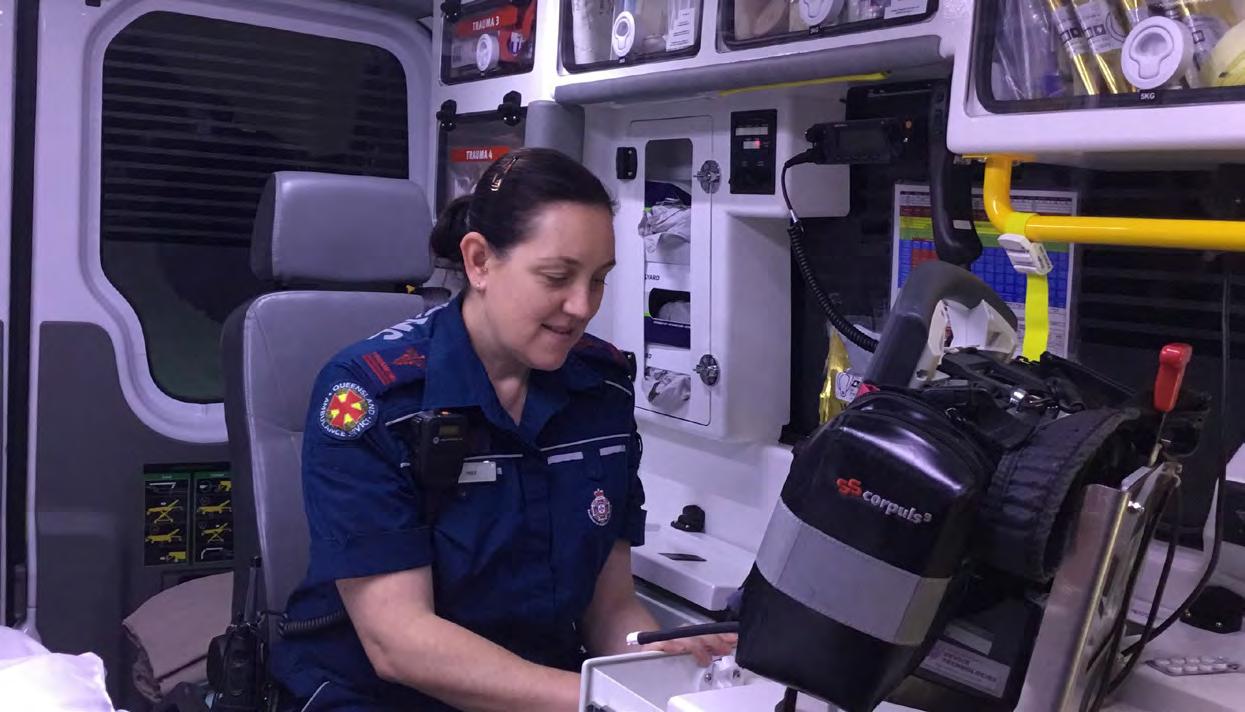
Left ■
injecting Right
TI Background ■
40 Winter/Spring 2021
ICP
■ Deidre Whap with medical kit at
Burns - Melanie

The completion of a new state-of-the-ar t communications training centre for Emergency Medical Dispatchers (EMDs) at the School of Ambulance and Paramedic Studies (later moved to Lutwyche) was an exciting development in QAS staff training. The upgraded centre replicated the QAS Triple Zero call centre and provided a more realistic environment for more effective EMD training.
In 2008, ambulance patient safety was enhanced by two new systems, the Clinical Audit and Review Tool (CART) and the Secondary Triage and Referral (STAR) strategy. QAS was the first service to introduce the CART technology, designed to monitor patients’ pre-hospital care standards more closely.
Complimenting this was the change from paper-based patient care reports to electronic reporting and analysis. CART identified the need to better manage ambulance service demand, dealing with low acuity calls –those not needing a traditional ambulance emergency response.
What followed was an important project during 2009 – the development and implementation of the STAR strategy to maximise the Service’s response to urgent cases. This new and more effective system allowed QAS to tailor its response to individual patient needs and to reduce unnecessary demand on emergency ambulances.
An exciting and challenging part of being a paramedic in the mid-2000s, was the extension of the Helicopter Rescue Services and the formalisation of the role of Flight Paramedic. In 2007, 70 QAS paramedics were flight trained, 80 per cent of them were Intensive Care Paramedics and the remainder Advanced Care
Paramedics. They began working from aeromedical bases around the state, travelling to areas inaccessible to ground crews.
An equally exciting development was the trial of a Motorcycle Paramedic response from 2000 to 2005.
Two Honda motorcycles, a Honda ST1100 road motorcycle and a Honda 250cc off-road motorcycle, were introduced into the QAS’s Gold Coast in April 2000. These initially began as a trial rapid response to emergency situations. Selected QAS Intensive Care Paramedics underwent specialised police motorcycle training to operate the motorcycles under emergency response situations. While four paramedics were eventually trained in motorcycle operation, the trial did not transition into a part of QAS response service.

In the mid-1990s a QAS-commissioned Hovercraft ambulance was trialled in the Thursday Island area to ferry patients to Horne Island, where the main airfield for evacuating patients was located. The hovercraft struggled with choppier waters and current speeds so after serving for several years, the hovercraft was sold in 2002 to a private buyer.
Another important innovation trialled in 2009 was a mobile ultra-sound trial unit, which provided on-scene early confirmation of internal damage and bleeding.
These were all truly life-saving advancements during this second decade.
41 Winter/Spring 2021 Celebrating 30 years as QAS
Background Rescue chopper and paramedics 2007.

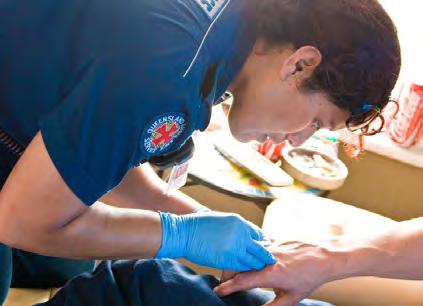
Meanwhile also, in 2009, building work was well underway on the new Queensland Emergency Operations Centre (QEOC) at the DCS Kedron Park complex. When it was completed in mid-2011, the QEOC became the new headquarters for the QAS, QFRS and Emergency Management Queensland (EMQ). It housed an enhanced Queensland Clinical Coordination Centre (QCC), run jointly by QAS and Queensland Health, to coordinate medical aircraft dispatch across the State. The new complex also became home to the Greater Brisbane Ambulance Communications Centre. It included a telemedicine service enabling senior doctors to advise and consult with remote area medical professionals in remote areas. A secondary Triage and Referral System in the centre provided medical advice and direction for patients not requiring an ambulance. The QEOC became a Triple Zero (000) nerve centre that coordinated day-to-day emergency responses more effectively and improved the management of large-scale incidents and disasters. The Centre was put to the test during the 2011 Queensland Flood events across the state.
The introduction and enhancement of the new QAS Special Operations response team came during and in response to Cyclone Yasi and other large events and incidents.
The November 2004 Tilt Train derailment on a bend at Berajondo near Rosedale saw all 150 passengers and seven crew members on board injured, two seriously. This triggered an enormous emergency response with QAS staff playing a significant role in challenging conditions.
In the following years there were several biological threats on a global scale including the H1N1 Influenza situation, the equine and avian flus and then the SARS virus. These forged a much closer relationship between QAS and Queensland Health and sparked a new focus on the training and use of Personal Protective Equipment (PPE) for QAS paramedics.
In 2011, Cyclone Yasi hit the Far North Queensland coast. Cairns was one of the predicted landfall locations, and as Yasi crept toward the coastline the decision was made to evacuate Esplanade-fronting Cairns Base Hospital and the Ramsay Health Care-run Cairns Private Hospital. QAS undertook one of its most challenging operations in history, relocating more than 330 patients from the two hospitals and surrounding nursing homes to medical facilities in the state’s south. The huge task fell to a team of around 150 paramedics, QFRS firefighters, SES volunteers, Queensland Health staff, airport staff and personnel from the Australian Defence Force and Royal Australian Air Force, who worked around the clock to effect the largest medical evacuation in Australian history.
42 Winter/Spring 2021
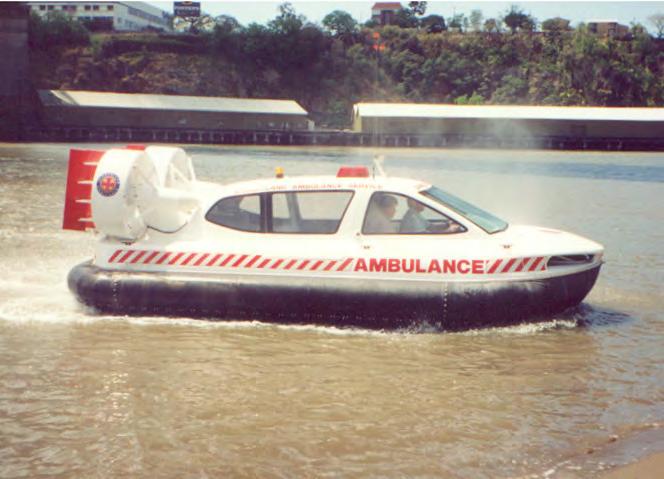
During the second decade many Queensland communities saw the opening of a new ambulance station or an increase in their local paramedic team. The QAS was growing in line with the state’s rapidly growing population.
QAS benefitted from the support of its large number of LACs which continued to support the Service since the transition from QATB. They made (and continue to make) a significant contribution as QAS volunteers. As members of the Queensland Local Ambulance Committee Advisory Council (QLAC), our QLAC members represent the Local Ambulance Committee (LAC) members for their region and provide LAC input to the Service at a statewide level.
During these two decades, we saw more women joining our paramedic ranks and Department of Community Safety (DCS) Director-General Michael Kinnane announced a women’s reference group during the International Women’s Day celebrations in 2001.
The loss of QAS paramedics in two fatal helicopter incidents inspired the new role of QAS Chaplain. Lindsay Roberts was appointed to provide support and assistance to the Priority One Program.
In the public arena, a new QAS website was developed providing information about the Service, its various operations, the ambulance subscriber scheme, and information for nonscribers. It also included information about its community education courses and some first aid tips. The ambulance subscriber scheme was to disappear during the second decade.
In June 2002, the then Premier Peter Beattie announced a tender process with private health funds to explore alternatives to the subscription scheme. In 2003, the Government announced the introduction of the new Community

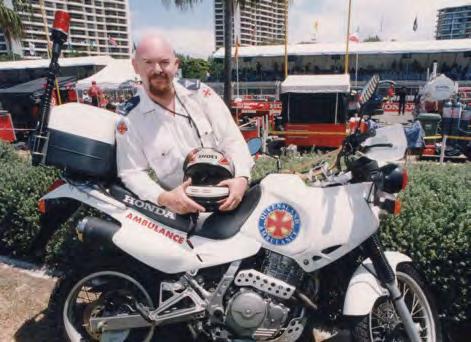
Ambulance Cover (CAC) initiative to provide “a secure and sustainable source of funding for QAS, replacing the QAS Subscription Scheme”. Before the decade was done, consolidated revenue was funding QAS, with no charge to any Queensland resident.
QAS’s second decade (2001 to 2011) was a period of further modernisation of the Queensland ambulance, a period over which a new level of public trust, clinical credibility and professionalism evolved.
QAS was ‘growing up” and the beneficiaries of these significant changes were our patients, the community and the ambulance allied health and emergency services and our other key stakeholders. By this time, our workforce had also evolved into a younger, more qualified, and more gender and culturally diverse uniformed group.
From June 2011, with many of these enhancements achieved, a new and younger QAS Commissioner Russell Bowles ASM was preparing to take us on the journey into the next decade.
Davis AM ASM
Mick
Left
■ QAS Hovercraft Cir 1990s. Middle
■ QAS fleet evolution.
Right
Winter/Spring 2021 Celebrating 30 years as QAS
■ Brett Ferguson ICP Gold Coast The Beacon Oct 99 43
What is the Clinical Hub?

Introduced in March 2020 as an initiative of the Queensland Ambulance Service (QAS) pandemic response, the Clinical Hub is a secondary triage service that prospectively reviews pending incidents. The Clinical Hub is based in the Brisbane Operations Centre (Brisbane OpCen), and operates from 8am to midnight and comprises a multidisciplinary team including Emergency Medical Dispatchers (EMDs), senior paramedic clinicians and ambulance medical officers (emergency physicians).
The Clinical Hub’s primary role is to conduct an in-depth secondary triage and patient assessment of a select cohort of patients to determine the most appropriate healthcare pathway proportionate to the acuity of the presenting complaint. The Clinical Hub currently reviews specifically selected Medical Priority Dispatch System (MPDS) determinants within the following regions: Far Northern, Sunshine Coast and Wide Bay, Metro North, Metro South and Gold Coast. Coverage will be progressively expanded to the entire state.
The Clinical Hub also oversees and coordinates hotel quarantine and potential COVID-19 incidents in collaboration with the State Operations Coordination Centre (SOCC), which operates from the Geebung Fleet and Emergency Management Precinct.
How does it work?
After an EMD receives and triages an initial emergency call, appropriate cases are filtered into the Clinical Hub. These incidents are then reviewed by a clinician who performs a secondary telephone assessment. Clinicians follow a semi-structured pathway that determines the primary complaint of the patient, the presence of specific symptoms and pertinent negatives, any relevant medical history and the patient’s social circumstances. This assessment mirrors what would occur if a paramedic attended the patient physically in the field.
Following completion of the telephone triage, the clinician determines the appropriate means for the patient to access healthcare and subsequently coordinates their entry into the healthcare system. Treatment options include: (i) dispatch of an emergency ambulance; (ii) dispatch of a Local-area Assessment & Referral Unit vehicle; (iii) transport by private means to hospital (iv) referral to a local general practitioner; (v) admission of the patient into a virtual emergency department; (vi) provision of self-care advice. If suitable and appropriate, the clinician can enact various referral pathways and the ambulance response will be cancelled. The cancellation of an incident occurs as a joint decision between the clinician and patient, in accordance with standard cancellation procedure.
What are the Benefits?
Alternate Pathways
The model of care that underpins the Clinical Hub enables an innovative approach to ambulance resource allocation. This nuanced approach positively influences the patient’s continuum of care and ensures the allocation of the right care to the right patient. Currently the Clinical Hub reviews approximately 200 incidents daily, with 40 patients safely referred to alternate pathways and the ambulance response cancelled.
44 Winter/Spring 2021
Telehealth
As an adjunct to the telephone triage, Hub clinicians can undertake telehealth calls with patient consents. This initially occurred using ‘FaceTime’ or ‘Google Duo’, depending on a patient’s phone operating system of the patients’ phone. This process allows the clinician to see the patient, allowing for a more thorough assessment. Additionally, this helps to build rapport by making the patient contact more interactive. We have recently moved to a dedicated direct telehealth option that doesn’t rely on a mobile operating system dependent.
Patient Safety
During the telephone intervention, clinicians may identify symptomology indicative of a serious condition that requires more urgent ambulance dispatch. If this occurs, the incident is reclassified and is dispatched under the standard ambulance response model. The Clinical Hub acts as a safety-net, ensuring patients with significant clinical indicators are promptly identified and an appropriate ambulance response occurs.
Virtual Emergency Department
The Metro North Virtual Emergency Department (MN VED) is an established referral pathway that collaboratively determines the most appropriate healthcare pathway for patients who the QAS have initially assessed. Patients managed through this pathway are reviewed by a hospital emergency physician who provides guidance to the paramedic on appropriate treatment pathways. Disposition options include community care arrangements, patient transfers =to an alternate pathway, or conveyance to hospital if clinically required.
Patients within the Metro North region presenting with a non-urgent complaint and who are considered stable after a physical and clinical assessment can be referred to the MN VED by calling the QAS Clinical Consultation & Advice Line.
QAS Medical Officers
The QAS has engaged several emergency physicians to work within the Clinical Hub. They provide clinical oversight for both the Clinical Hub, and the QAS OpCens more broadly. These medical officers have extensive experience across the health system, including working with the QAS on the High Acuity Response Unit (HARU). With this experience they understand the skills, training, methods and inherent challenges of pre-hospital care. This allows for tailored advice and assistance to be provided to both frontline clinicians and patients.

Recent Case Example
• A Triple Zero (000) call was received for an eye injury at night in a remote rural setting.
• The location was isolated due to localised flooding, and a traditional response would not have been able to access the patient.
• Preparations were commenced for a Royal Flying Doctor Service (RFDS) retrieval to the location.
• The local QAS OpCen appropriately identified this as a complex case which could be either high risk, or low acuity in nature and contacted the Clinical Hub.
• The Clinical Hub medical officer was able to connect directly with the patient via telehealth and undertake an assessment.
• It was identified there was an apparent eye injury, but it would be suitable to wait until it was light for the patient to be extricated.
• Advice was given to the patient, and they were able to wait until the morning to proceed to hospital.
This bespoke assessment and management provided a proportional and appropriate response to the patient. Instead of a nighttime retrieval to a remote and unprepared location by RFDS, the patient was extricated via a private mustering helicopter during daylight hours which significantly reduced the risk to all parties involved.
What is the
Clinical Hub?
45 Winter/Spring 2021
Opposite, from left to right Clinical Hub Team Leader Jess Patch, Clinical Hub Clinician Ash Panta and Emergency Despatcher Elaina Morris
OpCen Report
Insight’s OpCen Report highlights examples of outstanding responses to Triple Zero (000) calls by our dedicated staff at Operations Centres around the state. Officers in this edition’s OpCen Report have received commendations from QAS Clinicians or patients whose lives they have impacted.
Taylah McGhee
Emergency Medical Dispatcher (EMD) Taylah McGhee is a brand-new student who demonstrated the skills of a veteran EMD when she provided excellent CPR instructions only nine days after being signed off in Call Taking. Her call was reviewed and found to be a Highly Compliant call.
The SOS called the OpCen to thank Taylah and the rest of the Rocky team, stating Taylah “…Saved a lady’s life today”! The CPR was excellent. She is currently sitting up and talking in hospital.”
Taylah demonstrated the importance of appropriate clarification at Case Entry which allowed her to get “hands on chest,” rapidly
The patient had passed out while eating. When asked “Is she awake?”, the caller responded, “No…. she’s…… Yeah…. she’s…..”. Taylah correctly clarified by asking “Is she conscious” to which the caller said no, she’s not, her lips have all gone purple. Taylah quickly moved through Protocol 9 and onto CPR carefully clarifying her instructions when needed and taking control whenever required.
Blair Mowle
Rockhampton EMD, Blair Mowle, demonstrated genuine empathy when talking with a suicidal first party caller experiencing a mental health crisis.
There may be occasions where the Mental Health Liaison Clinicians (MHLCs) are not available for a warm transfer and you are required to stay on the line.
You can click here to listen to this call
Staying on the line with a caller can be difficult, particularly with a suicidal first party caller experiencing a mental health crisis. It can be difficult to know what to say in these situations. While appropriately unscripted, Blair did an excellent job of keeping the caller on the line and talking. In these situations, what you talk about is up to you. The purpose of staying on the line is to try and postpone their attempt at self harm or suicide, until help can arrive.
Elgan Rees
Cairns OpCen Student EMD Elgan Rees also demonstrated the skills of a veteran when he provided highly compliant CPR instructions to an extremely distressed partner of a young man.
When Elgan answered the call and heard the obvious distress in the caller’s voice, he immediately reassured her with, “We’re going to get some help for you.”
It quickly became clear the caller’s young partner was in cardiac arrest. Despite really poor phone line quality, Elgan was able to extract additional information while providing constant reassurance, encouragement and emotional support. Every time the caller had a “refreak”, Elgan was able to re establish control of the call and get her to continue CPR.
A refreak is a largely predictable event and may occur during a call when the caller reacts to seeing or being reminded of the patient’s state of distress. It is much more likely to occur when a patient is a relative or loved one. Elgan’s calm demeanour, provision of regular reassurance and effective use of the caller’s name, enabled him to establish trust with the caller and she quickly responded to the required instructions.
Nicole Patching
Southport EMD Nicole used her skills and technology to rapidly locate a patient suffering a life-threatening illness.
The patient and his wife were travelling west bound from Bribie Island when he started experiencing severe chest pain. Nicole received this call in the Southport Operations Centre and was unfamiliar with the location.
The caller was painting a picture of the location, but the road names being provided were incorrect. Nicole then used the Advanced Mobile Location (AML) polygon to pinpoint the location on the map and was able to complete the picture and confirm the exact address with the caller.
Nicole’s quick thinking allowed a rapid response of a crew and resulted in a positive outcome for the patient, who has since requested that Nicole be thanked for “saving his life”.
Introduced by Telstra in January 2021, AML is relatively new technology capable of providing highly accurate location data when the caller is using an AML enabled smart phone. The use of AML may enable an EMD to rapidly geo verify and incident location particularly in instances where the caller is unsure of their exact location. EMDs are encouraged to take AML data into consideration when geo verifying addresses.

Rockhampton Rockhampton
Cairns
Southport
Operations Centre Report 46
Winter/Spring 2021


Winter/Spring 2021 ACPIC 2021 SAVE THE DATE ACP International Conference 25 – 26 November 2021 An in-depth, comprehensive conference providing the education that paramedics at all levels need. Visit www.paramedics.org/events for more information #ACPIC2021 www.paramedics.org @ACParamedicine
FAQs about Fair and Inclusive Practice Network (FIPN) and QAS RESPECT
Why is this important?
Every QAS employee has the right to come to work and feel safe, supported and able to be themselves.
In the QAS, our workforce is our greatest asset. So, the question is how can our organisation help you perform your job of providing ’Excellence in Ambulance Services’ to our community to the best of your ability?
The QAS aims to enact best practice and exceed our legislative and social responsibilities to better support you when you come to work.
Your feedback consistently informed us staff wanted a more flexible, fair, diverse, inclusive, and respectful workplace… and we agree.
The QAS acknowledged this, acknowledged the areas for improvement, and started defining our future state.
Our Executives recognise a concentrated effort to reform this area now, will drive a culture of innovation and longterm sustainable improvement, where employees feel engaged and safe to come to work every day.
Fair and Inclusive Practice Network (FIPN) and QAS RESPECT has provided a vehicle for cultural change, operating as a local and statewide feedback mechanism. Both initiatives engage our employees, empower important conversations, and explore practical solutions to reform and build our future workforce.
How does this relate to our patients?
Research clearly shows organisations providing a positive culture have better employee engagement, productivity, innovation and overall satisfaction. This can also be linked to improved patient care, reduced fatigue, and reduced clinical errors.
Our patients notice when our staff are dissatisfied at work. One way to improve our patients’ experience is to ensure our employees are engaged, respected, and satisfied at work. Ultimately, workforce engagement and patient experience are connected.
This is where FIPN and QAS RESPECT are key in embedding a positive workplace culture, where flexibility, fairness, diversity, inclusivity, and respect is ‘business as usual’; and you can continue your important role within our health system.

A Q
What is a FIPN Officer?
FIPN Officers are dedicated QAS staff members who perform an important role by providing advice to employees and managers about information sharing, development and implementation of local and statewide initiatives, all designed to support fair, inclusive and respectful workplace practices.
Our FIPN Officers work collaboratively with Region/District Managers and supervisors to drive local and statewide culture reform. The Network currently has 49 FIPN Officers located across Queensland, comprising supervisors, paramedics, patient transport officers, emergency medical dispatchers and corporate staff.
Why would I contact a FIPN Officer?
FIPN Officers provide an alternative avenue for people wanting confidential advice or support, outside the traditional lines of reporting. FIPN Officers support reform across the key focus areas of:
• parental leave,
• transition to retirement,
• working whilst caring,
• respect at work,
• flexible work, and
• domestic and family violence.
To date, FIPN Officers have received more than 730 contacts from the workforce with 53 per cent of contacts being to seek advice. Key themes emerging include issues around bullying and harassment, racism, discrimination, particularly related to pregnancy (suitable duties, higher duties, entitlements, returning from maternity leave), flexible work, sexual harassment, gender equity and diversity and inclusion.
How do I contact a FIPN Officer?
There is a FIPN Officer Contact List on the QAS Portal. Or you can contact your Manager or Supervisor, Priority One, HR Representative, Commissioner’s Confidential Hotline or UWU delegate for information or support.
48 Winter/Spring 2021

What happens when I call the Commissioner’s Confidential Reporting Line?
If you don’t feel comfortable, or you are unable to raise issues at the local level, both the FIPN Coordinator and the Commissioner’s Confidential Reporting Line are available. The Commissioner’s Confidential Reporting Line was specifically created to provide a confidential avenue for staff raise issues. You can call (07) 3635 1598 and leave a voice mail message or email QAS.Complaints@ambulance. qld.gov.au, and one of the Directors in the Office of the Commissioner will respond to you.
In responding, each situation will be individually considered and evaluated to ensure the most appropriate and effective outcome is achieved. We are mindful of the sensitivity of situations and information disclosed, will dictate the course of action taken in consultation with the employee, wherever possible.
At times information provided may constitute corrupt conduct, notifiable conduct, criminal offences, threats to a person, or significant risks to the person’s or another’s health and safety. In this case the QAS is lawfully required to report the situation.
Why do I have to attend QAS RESPECT Training?
Sixty per cent of the QAS workforce has now completed the QAS RESPECT Training through Priority One. Well done everyone! Please register for a training session if you haven’t already, by contacting your Clinical Education Unit. The countdown is on as training finishes on 24 December 2021.
QAS RESPECT Training ‘Understanding Sexual Harassment in the Workplace’ is a QAS RESPECT initiative and a direct result of workforce feedback. This training aims to address the social and cultural context of sexual harassment and inappropriate behaviour more broadly.
Managers and employees have a common understanding of acceptable and unacceptable standards of behaviour within the organisation, knowing how to intervene and the pathways available. The QAS aims to empower the workforce to eliminate inappropriate behaviours and inequities and create a positive and respectful culture.
The training has been designed and delivered by Priority One’s psychologists due to the sensitive nature, the psychological context and their insight and understanding of sexual harassment within our unique frontline service.

FIPN Conference
In September, the FIPN Conference provided an opportunity for FIPN Officers alongside QAS Central Office Executives and Regional Assistant Commissioners, to again collaborate and progress the FIPN and QAS RESPECT agenda.
Conference discussion themes included complaint management; meaningful five-minute conversations; Priority One’s session on mental health maintenance and support; and Australia CEO Challenge which facilitated training on domestic and family violence. The conference was successful and reconfirmed the organisation’s commitment to building flexible, fair, inclusive and respectful workplaces.
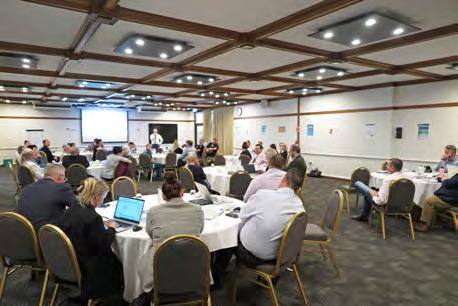
49 Winter/Spring 2021 FIPN/RESPECT
QAS RESPECT: Celebrating one year
September marks the one year since QAS RESPECT was launched and there has already been significant wins, resulting in positive reform.
QAS RESPECT is now considered in our day-to-day functioning of the Service
More than 53% of QAS workforce have completed QAS RESPECT Training by Priority One across 82 training days
• A total of 2,939 staff were trained (674 managers and 2265 non-managerial staff)
• Training completed for Far Northern, Northern and Central Regions
Governance was established through the QAS RESPECT Steering Committee, QAS RESPECT Working Group, FIPN Network including the Respect at Work SubGroup, strengthening our staff-led strategy and feedback mechanism
Staff continue to report increased confidence to have conversations and felt empowered to intervene and address inappropriate workplace behaviour
Culture Action Plan was endorsed and underpinned by QAS RESPECT, 19 Districts and Central Areas have completed their initial briefing sessions and started their Culture Action Plan. Key themes include workplace behaviour, communication and engagement, education and training, and leadership
QAS RESPECT has been incorporated into QAS Role Description setting clear organisational expectations for workplace behaviour and links to QAS RESPECT website page
QAS achieved White Ribbon Workplace reaccreditation in July 2021
Do you have a roster preference?
Incorporated FIPN and QAS RESPECT into the QAS Induction Programs, reaching 6 cohorts and approximately 180 new employees joining the Service
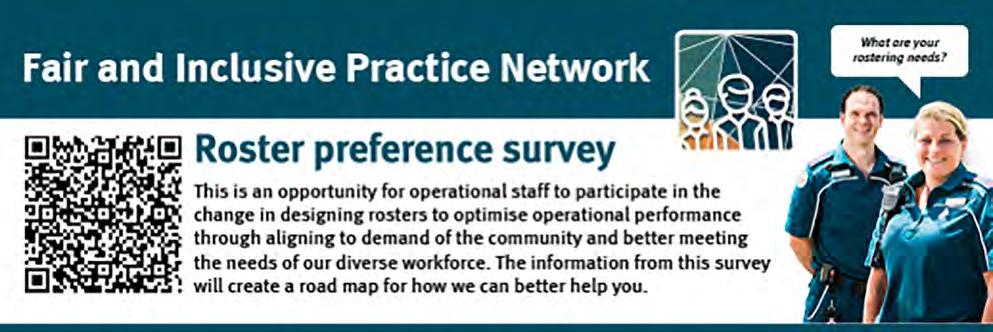
50 Winter/Spring 2021
AFL Commemorative Sports Day
On 12 September, QAS participated in the Emergency Services AFL match to mark the 20th anniversary of the terrorist attacks in the USA which later became known as 9/11.
Queensland Police Service, Queensland Fire and Emergency Services and Queensland Ambulance Service united to honour the lives lost in the tragedy and to pay homage to the bravery exhibited by emergency responders.
The QAS had its first women’s AFL team with more than 45 staff members involved in playing, volunteering or coaching.
Their first game was against eventual winners, QFES who, in their second year together, were dominant from the start.
The girls in teal then backed it up again straight after for their second game against a physical Police side.
Team QAS started to gain some confidence in the final quarter and had all the balls down their end, but couldn’t convert.
All teams agreed the scoreboard didn’t reflect the on-field effort and despite not scoring, they couldn’t wipe the smiles off their faces.
They’re looking forward to making it a permanent fixture in the years to come.
The Women’s AFL team was proudly sponsored by QAS RESPECT, providing the opportunity to continue the conversation and illustrate the organisation’s commitment to culture reform and creating flexible, fair, inclusive and respectful workplaces, where diversity is embraced and all employees can be themselves.
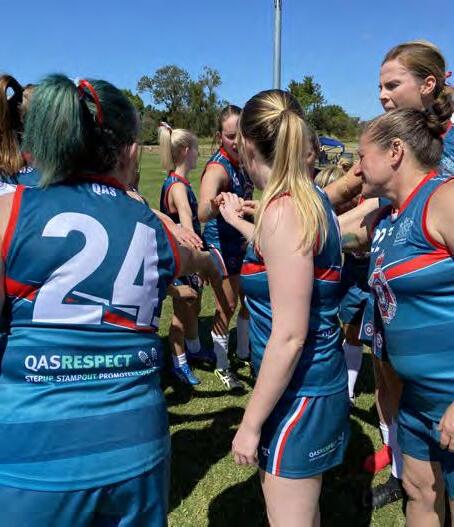

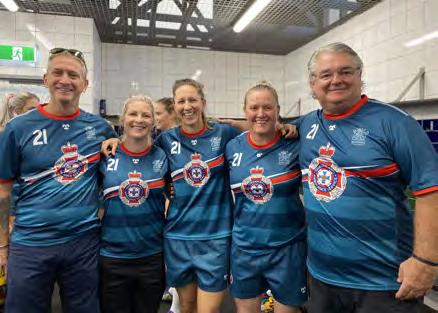

51 Winter/Spring 2021 FIPN/RESPECT
From top to bottom Hands in for Team QAS.
The inaugural QAS Women’s Aussie Rules team TEAM QAS coaches Ian Macauley, Peta Thompson, Mel Rogers (captain), Mel Bernas and Tim Eva.
QAS teamed up with QFES and QPS for the special commemorative sports day.
LARU Report
Queensland Ambulance Service’s (QAS) Graduate Certificate in Enhanced Assessment and Critical Reasoning has delivered two units of competency concurrently over the past five months.
During April, a new cohort of learners started their studies in conducting enhanced assessments of patients with complex care needs.
QEII Emergency Department’s Staff Specialist Dr Caroline Hwang provided lectures and practical sessions on advanced history taking and advanced physical assessments.
These ‘hands on’, highly practical sessions were very engaging, and learner feedback was positive. The new skills are currently being transitioned into their daily patient care practices.




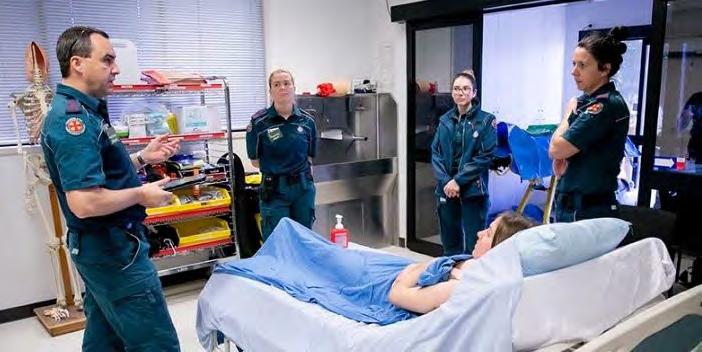

During June another cohort of learners started their studies in Assess and Provide Treatment of Wounds, where learners were skilled in skin closure – suturing, skin tear management, skin adhesion, aseptic non touch technique, fishhook removal, emergency removal of restrictive rings/bands, local and regional anaesthesia including digital block.
The residential was run at Whyte Island, and the learners continued their studies back in their Districts through online knowledge and skills assessments. This course has recently finished, and all learners gained their wound management and closure credentials and are now performing their newly acquired skills in their communities.

52 Winter/Spring 2021
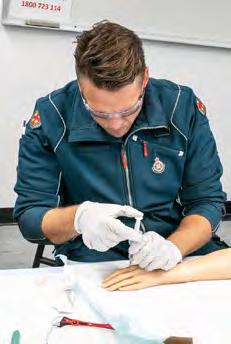
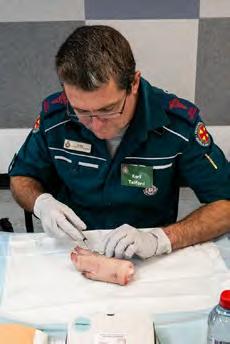


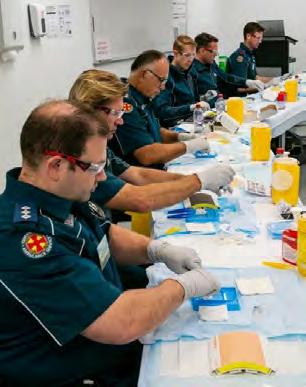




Local area Assessment and Referral Unit Report 53 Winter/Spring 2021
CASE
The QAS was called to a female in her 30s who suffered a seizure at home. She had delivered her second child four days earlier.
QAS Medical Director Dr Stephen Rashford
The pregnancy had been complicated by Pregnancy Induced Hypertension (PIH). A diagnosis of pre eclampsia was made during labour. The patient had been discharged on labetalol (beta blocker) and enoxaparin (anticoagulant).
The initial history provided to the attending crews was that she suffered blurred vision and headache that morning, then suffering a seizure with a head strike. The patient’s partner then called QAS.
The initial attending Advanced Care Paramedic (ACP) crew found the patient in the right lateral position in the bathroom. Her airway was clear, she was breathing spontaneously and was well oxygenated. She had a strong radial pulse and her GCS was 11/15 (E3, V3, M5). Relatively quickly, the GCS improved to GCS 14 (V4). The ACPs had noted equal, reactive pupils, no focal neurological deficit, but the patient was tachycardic and mildly hypertensive. Nil respiratory distress was present. In addition, the blood sugar levels were normal, and she was noted to be afebrile. Intravenous access was gained, with the patient then extricated from residence using the stretcher.
Shortly after extrication, a second seizure occurred.
A Critical Care Paramedic (CCP), who had already been dispatched, arrived at this time. The High Acuity Response Unit (HARU) was also responded. The patient was now cyanotic, needing manual airway support with increased secretions. Midazolam was administered and a magnesium infusion was commenced.
54 Winter/Spring 2021
Upon HARU arrival, the GCS was 7/15 (M5), there was a deviated gaze to right, the pupils were 2mm, the systolic blood pressure was 170 mmHg and the heart rate was 120 beats per minute. The patient became progressively more agitated, with a further rise in blood pressure. Given the escalating presentation, a decision was made to electively intubate the patient, allowing for deep sedation to prevent further seizure activity and address potential cerebral oedema. Initial control was gained by boluses of propofol (intravenous anaesthetic agent with anticonvulsant properties).
A rapid sequence intubation (RSI) with 150 microg fentanyl, 150mg propofol and rocuronium 100mg was then undertaken. The endotracheal tube was passed on first attempt, but the larynx was noted to be very oedematous.
Post intubation, the patient was noted to have poor ventilatory compliance and pulmonary oedema was suspected, therefore the positive end expiratory pressure (PEEP) was increased with good effect. Sedation was continued with a propofol and fentanyl infusion. A further bolus of magnesium was administered. The blood pressure had now reduced to 130 140 mmHg.
The patient was diagnosed with posterior reversible encephalopathy syndrome (PRES). This syndrome is a result of significant vasogenic oedema in the brain, notably associated with the diagnosis of Eclampsia. The patient remained ventilated for 10 days but went on to make a full recovery.
DISCUSSION
• Patients are at risk of pregnancy associated conditions for up to six weeks post partum (including Eclampsia and venous thrombosis)
• The airway physiology and anatomy in the post‑partum period is the same as during the late antenatal phase of pregnancy – including swelling to airway, potential for pulmonary oedema, reduced functional residual capacity (FRC) with atelectasis and reduced lower oesophageal sphincter tone with increased aspiration risk.
• The treatment aims of Eclampsia primarily rest with blood pressure and seizure control. For significant presentations, consider early magnesium administration before progression to a seizure. If any doubt, use the 24/7 consultation line.
• The complications of Eclampsia may be severe, including PRES and hepatic/haematological/platelet dysfunction syndromes.
• This was a rare complicated case but very well managed by the ACPs, CCP and HARU team involved.

High Acuity Response Unit Report
55 Winter/Spring 2021
Image
Post intubation CXR, demonstrating good placement of the ETT and gastric decompression tube. There are increased lung interstitial markings, consistent with mild pulmonary oedema.
Behind the frontline: State Operations Coordination Centre (SOCC)
COVID-19 Pandemic is unprecedented in the history of the Queensland Ambulance Service (QAS).
More than a year after the World Health Organisation (WHO) declared the COVID 19 event a pandemic, the QAS, as an integral part of Queensland’s broader health system, continues to operate at the frontline of Queensland’s most significant events and disasters across the state.
By virtue of its practised and embedded disaster management arrangements, the QAS was, prior to the declaration of the COVID 19 pandemic, well positioned to respond to an emerging threat to its service delivery arrangements.
Through experiences in planning for and responding to natural disasters as well as wide scale events including the 2018 Commonwealth Games, the QAS had gained a high level capability in strategic, operational and tactical leadership, as well as developed systems of coordination founded on Australasian Inter Service Incident Management System principles and processes.
key strategies to meet the significant and unknown challenges posed by this event. A key activity was identified through the early activation, on 30 January 2020, of the QAS State Incident Management Room (SIMR), as it was named at the time. The activation of the QAS SIMR and the integration of QAS personnel into the Queensland Health State Health Emergency Coordination Centre (SHECC) provided a platform for a coordinated joint agency response, collaborative organisational planning and provide communication pathways for early intelligence and planning.
As the QAS response to the COVID 19 Pandemic event continues to be proven successful, it is also the case that the QAS has gained several legacy initiatives developed because of the planning approach undertaken.
Eighteen months later, the QAS SOCC (as it’s now known) has become an important part of the permanent QAS The
Utilising an integrated approach, this centrally coordinated model ensures the management of QAS service delivery, systems and processes align with QAS strategic and performance objectives. The establishment of a dedicated coordination centre was structurally achieved by integrating the existing functions undertaken by the SIMR, the Patient Safety Distribution Unit (the PSDU), and the Clinical Hub. Incorporating these existing business units continues to allow an integrated management system providing a clear point of control, coordination, and oversight from a statewide perspective through critical business units, working as a centrally coordinated resource providing:
• System direction and integration (via the SIMR).
In January 2020, as the intelligence around the COVID 19 pandemic rapidly emerged, the QAS activated
On 29 April 2021, the QAS Governance Committee endorsed the transition of the State Incident Management Room (SIMR) to a QAS State Operations Coordination Centre (SOCC) as a permanently activated establishment at the QAS Emergency Management and Fleet Precinct, Geebung.
• Real time system monitoring (via the PSDU).
• System based patient/clinical intervention (via the Clinical Hub).
State Incident Management Room (SIMR) State Operations Coordination Centre (SOCC) Common Operating Picture Planning Intelligence Clinical QAS Strategy Operation Centre Communication Medical Expertise Stakeholder Engagement Capability Knowledge Management Improved Coordinated Outcomes COSE reporting Deployment Management Regional Notification Staff wellbeing BaU Operations All Hazards Coordination Clinical Hub (CHUB) Patient Safety Distribution Unit (PDSU) Local Ambulance Coordination Centres (LACC) 56 Winter/Spring 2021
operating structure. Located at Bilsen Road, Geebung, the SOCC is a busy 24/7 operation providing real time operational oversight and assurance to the QAS’s service delivery systems. The SOCC is modelled on the Australasian Inter Service Incident Management System (AIIMS), a nationally and internationally recognised Emergency Management framework encompassing functions dedicated, but not limited to:
• Intelligence
• Operations
• Planning
• Medical Services
• Public Information
• Logistics
• Safety
Operating under the QAS Strategic Operations portfolio, with the delegated authority of the QAS Commissioner, it delivers on the strategic direction set by the Central Office Senior Executive (COSE). Working closely with the state’s Operations Centres, Emergency Management Unit, and the Regions, the SOCC can provide strategic, operational, and tactical oversight of ambulance operations thorough a command, control and risk management approach.
Acting Deputy Commissioner Stephen Zsombok said the SOCC is the connection between the Senior Executives and all operational aspects of QAS. “In addition to our business as usual operations, we’re responding to COVID, preparing our emergency and disaster management capability, and managing major events and incidents,” Steve said.
“Having a strategic view combined with operational and disaster management expertise provides us with the intelligence, capability and readiness to respond effectively, and at short notice.”
The SOCC, utilising increased organisational visibility, can identify real time service delivery issues and outcomes, improving performance monitoring and reporting, rapid deployment, and the ability to resolve issues efficiently.
An Incident Management System (IMS) structure provides centralised operational directions that can be quickly disseminated and managed across the organisation mitigating risk and providing enhanced communication and coordination.
Through its close working partnership with the Emergency Management Unit,
the SOCC can deploy state assets and personnel like the Special Response Team (SRT) across Queensland to support operations, special events or disaster response.
Acting SOCC Director, Nigel Fordyce described the SOCC as a centrally coordinated operation which ensures consistent oversight, command, and control across the State. “We have an established, rotating shift staffing structure for business as usual operations, although sometimes it’s difficult to determine exactly what ‘business as usual’ means these days,” Nigel said.
“We’re responding daily to different cases and rapidly evolving situations amidst a global pandemic, so we have to be informed and plan strategically to maintain a high quality, real time response to the community.
“We’re also flexible enough with our structure to be able to escalate and expand our staff quickly to increase the SOCC’s capacity and capability to support the QAS response depending on the circumstances at the time.”
Nigel said on any given day, the SOCC coordinates large flows of information and communication, prepares intelligence and operations briefs, collaborates with regions, and provides advice and support across the organisation at the strategic, operational and tactical levels.
“Our ability to rapidly connect all resources across the state with appropriate intelligence from QAS executives, operational staff, Operations Centre (OpCen) staff and external agencies ensures a high quality response across Queensland no matter the location or incident. The QAS is one of the largest ambulance services in the world and statewide oversight is critical to our success and this is achieved through the SOCC.”
Prior to the SOCC becoming a permanent unit in 2021, during the 2019 2020 financial year the QAS Coordination Centre was activated for 196 days supporting the Whole of Government response to the 2019 Bushfires (Operations Redux), COVID 19 and concurrent 2020 February monsoon event.
As the community enters the summer, “November to April” storm season, the SOCC in collaboration with the Emergency Management and other state units will not only continue its daily
activities, but also prepare and respond to the anticipated natural hazards experienced during this time throughout the state.
The QAS would like to not only recognise the significant contribution that the SOCC and Emergency Management Unit teams continue to provide to the QAS, but also acknowledge the enormous impact the COVID 19 Pandemic event has had on individuals, communities and societies around the world, and particularly acknowledges the significant and tragic impact that current circumstances have had on the people of Queensland.
SOCC Snapshot
573
Days SOCC has been stood up
7038
Times a staff member has called Medical Services Cell to ask for advice
1719
Daily briefings since activation
1146
Emails to all QAS Staff with updates, including safety information and support
1629
Enquiries to provide advice to EMDs identified by the health screening process
11551
Reportable Covid 19 cases transferred into SHECC
792
QAS transport of confirmed Covid 19 cases
as at 25 August 2021
57 Winter/Spring 2021 SOCC
Celebrating our centenarians
Springsure, Mossman and Laidley Stations opened their doors recently, inviting their local communities to help them celebrate their centenaries.
Minerva Hills National Park provided a stunning backdrop for Springsure Station’s milestone event on 22 May, where there was plenty of fun for the community, including historic displays and a range of emergency service vehicles on site at the Eclipse Street Station.
Mossman Station celebrated its 100th on 26 June and the community enjoyed a good old sausage sizzle, CPR awareness sessions, and new and old ambulances on display.
Laidley Station celebrated its big day with the community on 24 July, with a display of current and heritage emergency vehicles, CPR awareness, sausage sizzle and face painting.





Springsure
58 Winter/Spring 2021


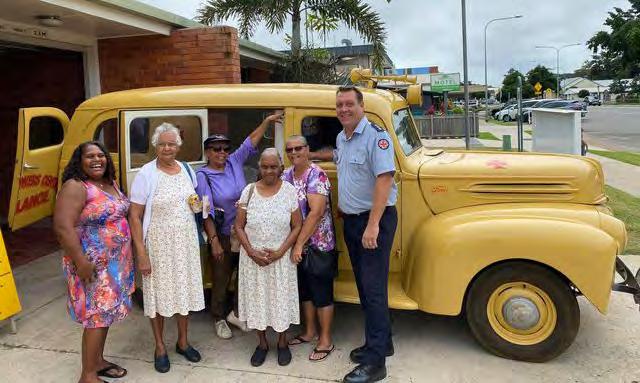


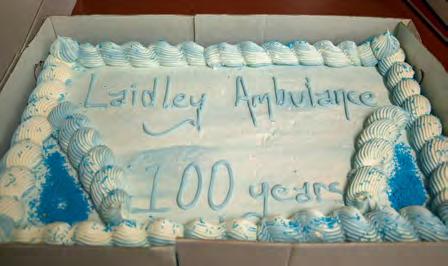




QAS Centenaries
59 Winter/Spring 2021
Mossman Laidley

Paramedic Mark provides support in Timor-Leste
QAS paramedic Mark Herewini left relative safety behind to travel to natural disaster hit Timor Leste (TL) in April this year to help stem its growing public health crisis.
Cyclone Seroja hit Timor-Leste over Easter, bringing torrential rain causing widespread flash floods and mudslides, with its capital Dili and its surrounding low-lying areas being the worst affected.
Dili was declared a “state of calamity” on 8 April at a time when communities had been living with strict COVID-19 lockdown measures. But 46 people had died (10 missing presumed dead), 4,384 homes were badly damaged or destroyed, and 12,378 people were temporarily displaced.
The knock-on health problems meant increasing reports of epidemic diarrhoea, vomiting and fevers from water and vector borne disease, epidermal infection, cellulitis and sepsis from poor hygiene and contaminated water supplies. Poor food security saw rising malnutrition rates.

Mark said he got involved when former colleague, retired Australian Army Major and Brisbane-based Honorary Consul of the Democratic Republic of TimorLeste Queensland, Michael Stone decided to form a humanitarian crisis assistance program and emailed veterans inviting expressions of interest about being involved.
“I put my hand up because firstly, my long relationship with TL, having spent a fair bit of time working there since 1999 serving as a Section Commander in the Australian Army and later returned with a group of INTERFET veterans in 2019,” Mark said.
“Secondly, I’d worked with Michael supporting him while serving there during civil unrest in 2007, and finally, because my current skillset as a QAS Advanced Care Paramedic meant I

could provide medical support and advice to the mission.
“This time our mission was to provide immediate relief aid, raise awareness of this disaster in Australia to increase support, and to gather on-site information to help the Timor-Leste and Australian Governments plan their responses to help the affected communities,” Mark said.
A mission GoFundMe page raised more than $72,000 and private donations included a charter flight from Darwin to Dili to get the team and supplies to their destination.
“All donations went directly to relief aid and all administration costs including transport, accommodation, meals etc were either self-funded or provided by sympathetic business

60 Winter/Spring 2021

owners like the Veterans Care Association and the North Gold Coast RSL Sub-Branch,” he said.
“The funds raised paid for 700kg of medical supplies, OTC medication, bedding and temporary shelters, forming the first shipment of international aid to reach TL.
“The Veterans Council received US$30,000 to provide food and essential items for communities, and medical NGO Saude Ba Ema Hotu (SABEH) received US$10,000 to provide outreach medical clinics to the most vulnerable communities during the crisis.”
Unexpected minor travel delays meant Mark spent some time observing NT Ambulance’s day and night shifts at the Casuarina Station.
“I gained valuable insight into the way the NT teams face the daily challenges of servicing remote communities with limited resources and care flight services,” Mark said. “One of the most useful tools the crews have access to is patients’ previous ambulance presentations, their medical history, medications and allergies.
“This was useful when presented with patients with ALOC due to trauma, drug or alcohol intoxication or when there was an index of suspicion for functional causes to their complaints,” he said.
Michael’s Honorary Consul status meant he arrived with the provisions eight days before Mark and an AUSMAT National Critical Care and Trauma Response Centre (NCCTRC). Mark and the AUSMAT team were the first and only international people permitted to enter TL after the natural disaster.
After completing quarantine, Mark and the other team members faced a capital city which on the surface looked unaffected.
“By that stage, most of the flooding had subsided and surprisingly, in Dili it looked like business as usual – more so than the previous month particularly as it included no mask wearing,” Mark said.
The government had lifted its COVID restrictions in response to the natural disaster for 30 days, as many people were displaced and had no shelter, food, or clean water.
“It was a completely different story when we went into the out-lying areas where we started to see the real devastation,” he said.
“There’d been significant mudslides, where sections of villages had been inundated with mud and debris.
“One of the worst affected areas in Dili was Tasitolu, or “Three Waters”, where the three flooded lakes cut the

community off completely and hadn’t receded after the flooding and had to be pumped out.”
Mark said the team spent its time working initially in the community with people whose houses were inundated by landslides. Its work also included running several outreach medical clinics with volunteers from SABEH, delivering food and essential items with TL Veterans and SABEH, and providing SABEH volunteers with first aid lessons.
Mark said there was no accurate reporting of community death and illness from COVID-19 as people avoided going to hospitals or notifying officials in case they were placed in mandatory isolation.
Disease identification was also proving difficult; making it harder to predict communicable disease spread like cholera and leptospirosis.
“While officials knew the daily COVID transmission rate was increasing, it was clear the figures weren’t accurate as the only people being tested were those seeking travel permits to leave Dili.
“They estimated at least 25,000 Dili residents were COVID-positive, with few notifying officials of deaths to avoid bans on traditional ceremonies and burials,” Mark said.

61 Winter/Spring 2021 Timor Support

“What we found was very limited laboratory testing to determine disease etiolology, respiratory or GIT infection and only severely ill people were taken to hospital,” Mark said.
“Emergency medical services had little capacity to respond to the less accessible regions and it was usually up to the SABEH volunteers to coordinate transport for the severely ill to primary healthcare facilities.
“At the outreach clinics, people were presenting with respiratory infections, diarrhoea, dermatitis and myalgia.
“Each clinic provided treatment to 80-150 patients of all ages with a professional efficiency you’d expect to see in a military triage system.
“Nursing staff triaged patients, recorded their details and noted initial vital signs before directing them to the doctors for consultation, who then wrote prescriptions for the pharmacist team to fill out. This entire process took about 15 minutes.”
Meanwhile, the Veterans Council distributed the much needed supplies the team had shipped in from Darwin, while Michael purchased tools and equipment to help with building repairs and had mobilised local young people to help homeowners with the near-impossible task of clearing out mud and debris from their homes.

“One person the team helped was a Timorese veteran whose house was inundated by mudflow during a landslide, but he’d chosen instead to help others in the community (it’s a veterans’ motto – the people come first).
“Michael and the young Timorese crew worked for two weeks to get his house ready to be lived in again. He’d lost all his furnishings and personal possessions but was grateful for the assistance we’d provided making his home habitable again,” he said.
Mark and the team were able to meet with the Timor-Leste Ambulance Service’s Director General who discussed the Service’s structure, capabilities and future development with them.
“They have a small Service comprising three stations in Dili operating four acute ambulances during the day, and two at night. The crews include a driver and an ambulance officer, both trained in Basic Life Support and at the central station they also have a doctor and a midwife on call,” he said.
“There are two doctors and two midwives in the Service, and they alternate 12-hour shifts 7 days a week. The crews have limited diagnostic equipment, trauma response stores or capacity to oxygenate patients when required.

“The doctors have a limited medication supply they can administer like oral analgesia and bronchodilator metered dose inhalers. The Service has two operational automated external defibrillators with the other units requiring servicing,” he said.
“While the Service is in the process of developing treatment protocols and training guidelines for their officers, this will take some time to implement. We inspected one of their acute response ambulances and I’m hoping to generate some interest in a collaboration with Australian ambulance services to help them improve their service.”
Mark said the Service had previously received some assistance from the Australian-funded Partnership for Human Development Health Program, but that had finished.
“As the Timorese were keen to expand their education, I was asked to conduct some lessons in first aid and basic life support,” he said. “The first lesson began as an informal lesson demonstrating how to use some of the trauma dressings brought over from Australia, but it turned into a master class on major haemorrhage control, fracture management and burns management.
“The second lesson was a structured lesson in a classroom setting on
62 Winter/Spring 2021

CPR. This lesson primarily covered BLS, but, introduced some relevant ALS protocols and went into much more depth when discussing resuscitation process.
“This session also included a clinical discussion on near-drowning based on the case of a young boy the volunteers had treated at the end of their last outreach clinic who had fallen into brackish, contaminated water –thankfully he survived.
“These were excellent sessions and were really well received despite our language barriers when discussing complex medical terminology and concepts through an interpreter without a medical background.”
Mark said he has set his sights on improving his Tetum language skills to a level where he can use medical terminology.
At the end of their time in TL, the team was invited to stay at Nobel Peace Prize recipient, former Prime Minister and President of Timor-Leste, His Excellency Dr José Ramos Horta’s house.
“His Excellency was a gracious and generous host who greeted us into his home with ‘My home is your home.’ This recognition of past and present efforts to help his country far outweighs any medals, awards or accolades and I am truly thankful for his hospitality,” Mark said.

During this time, the TL government reintroduced its stay at home orders and returned to enforcing strict COVID-19 movement restrictions, its rules around wearing PPE and maintaining social distancing, as well as a campaign promoting mass COVID testing.

“I hope I’ll be able to continue to play a role in supporting our neighbours and friends in Timor-Leste in future,” Mark said. “The fortnight I had there served as a big reminder about just how good we’ve got it here.

“This was an important response to increasing COVID-19 community transmission with 10 per cent of all those tested being positive, indicating a potential of 25,000-plus positive cases in Dili alone.”
“This spike was directly linked to the flooding crisis.”
Mark returned to Australia later that month, finished his quarantine at Howard Springs and returned to South Brisbane Station before heading out to Barcaldine Station in Central West District where he’s based while studying his Masters of Rural and Remote Medicine through James Cook University.
He said despite losing time to quarantine in both countries, the mission completed its aim –to provide significant aid to help reduce people’s suffering from the crisis, and to help them get back on their feet and into the future as the nation continues to develop.
“The local workers there don’t have the access to the resources we’ve got – just a whole lot of good will and they’re making the best they can out of what they’ve got.
“One thing this trip has taught me is the importance of basic human interaction – sometimes it’s not all about equipment, it can be as simple as being able to communicate with good intent – listening properly to people and being empathetic.
“It’s this positive interaction with people that can make a world of difference even if you don’t have the machines with all the bells and whistles.
“Finally, and most importantly, I’d like to thank QAS’s Assistant Commissioner Gerard Lawler and South Brisbane Station’s OICs, Jason Dutton, Mick Sweeney and Ingrid Wulfe for their advice and support for my request to join this humanitarian aid mission to TL.”
63 Winter/Spring 2021 Timor Support


Paramedics shine a light on road safety
Flashing sirens, a crumpled car and two young casualties front and centre set the scene for emergency services to drive home an important message for all Queenslanders, Madolyn Sushames writes.
In July, police officers, firefighters, paramedics and a trauma surgeon teamed up to create a series of road safety videos urging drivers to think twice before they get behind the wheel.
The Queensland Police Service campaign, launched at the start of Queensland Road Safety Week (16-20 August), detailed short, personal stories from the various people involved in road traffic crashes, from the first responders to patients and their families.
Carina Officer in Charge Jess Megaw and Logan West Officer in Charge Shane Henderson were involved in filming the videos and said after seeing the finished product they believed it would affect viewers.
“I hope we can reduce the road toll because we’re all human too and going to these incidents has a lasting impact on us,” Jess said.
Shane agreed.
“It’s so dark, gritty and realistic and I hope it does make people question their choices and make better decisions,” he said.
As part of the series, Shane spoke about his role in road traffic crashes as a paramedic and the effect it’s had on him.
“It was quite interesting to be asked questions about the emotional side of what we do because we spend so much focussing on the clinical and operational aspects, it was confronting to be talking about the emotional side,” he said.
His story intertwines with other emergency responders in an orchestrated, yet raw recount of various incidents commonly seen on Queensland roads.
QAS featured these powerful videos on our social media platforms during Road Safety Week to increase public awareness of the dangers of unsafe driving behaviours and remind people road safety is everyone’s responsibility.
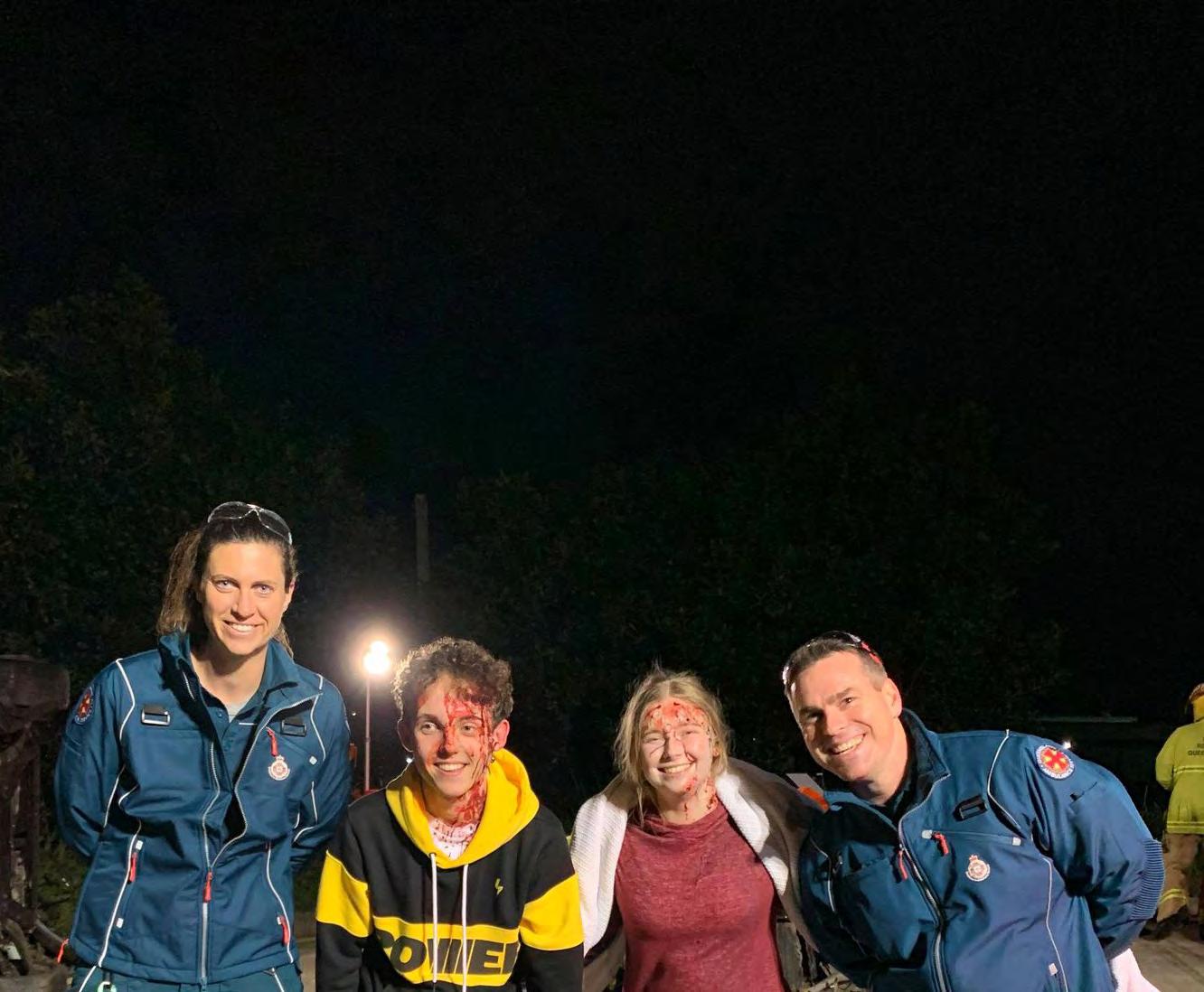
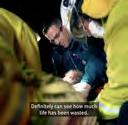
or go to: https://bit.ly/3mACFqu
Top
■
Background ■
64 Winter/Spring 2021
Click
here
to
view Shane’s video
Top
left
■
Shane Henderson is interviewed for Road Safety Week.
right
On set... mocking up a road crash.
Jess Shaw and Shane Henderson pose with two of their “casualties”.
Happenings

Rockhampton EMD Margaret Nelson retired recently after 21 years with QAS. In a special celebration she was presented with a Certificate of Appreciation, a plaque and a 20 years Long Service Medal.
Congratulations and farewell Margaret!

Vale Ernest Bradley OAM
On 15 July we shared the passing of one of our great stalwarts and passionate historians, Ernie Bradley.
Ernie was well known throughout the QAS family and sadly passed away just shy of his 98th birthday.
He remained an instrumental figure at QAS ever since 1938 when he joined the Cairns Queensland Ambulance Transport Brigade (QATB) as a clerical assistant and cadet ambulance officer at the age of 14.
Ernie would go on to work in Cairns, Mareeba, Ingham and Nanango before joining the State Executive Committee of the QATB in 1963.
He retired in 1987 as the Senior Administration Officer and Inspector of Committees on the board.
Ernie busied himself in retirement, compiling the “History of the Queensland Ambulance”, which catalogued the first 100 years of the service since 1892.
In recognition of his service to the QAS, he was awarded the Medal of the Order of Australia.
Even in recent years, Ernie remained an active volunteer and was a current member of the Queensland Ambulance Museum Committee and a life member of the QAS Retired Officers Association Inc.
Click here to find out more about Ernie’s wonderful life and his massive contribution to ambulance services in Queensland.

Warwick LAC sets a high bar for CPR
Warwick’s Local Ambulance Committee (LAC) has been working hard to boost their local community’s CPR skills, with Jack Barford demonstrating CPR to 30 clubs in the past three years.
Jack is hoping to visit more by the end of the year.
“I have been to schools, but not so much in the past year due to COVID-19 and I’ve also talked to one group of 80 at the Probus club,” Jack said. “An Allora club is talking to me about coming to a meeting to demonstrate CPR.
“It is also important that those who have learnt CPR do refresher courses and keep their skills up.”
LAC president Peter Stewart said QAS was held in high regard in the community.
“Our role is to support the local ambulance,” Peter said.
“While the ambulance is supported financially by the QAS, extra fundraising enables the LAC to help with a few extras at the station for its wonderful staff.”
Any more funds raised goes to the ambulance station in Warwick or the Killarney First Responders.

65 Winter/Spring 2021 HAPPENINGS • Winter/Spring 2021

THANK YOU :)
Acting Commissioner’s thanks
Everyone has different levels of success. For me, success can never be achieved unless you have the desire to initiate it. The amazing work and commitment from staff that continuously results in appreciation letters we receive from members of the public, makes me constantly aware of what accomplishments we have made as an organisation.
The QAS workforce is comprised of many interconnecting pieces and everyone should be proud of the role they play in the QAS providing exceptional prehospital emergency care.
This month has seen an influx of thank you letters, with 304 letters received this year to date and 609 letters and emails of thanks sent to staff members.
Thanks to Ambo Nathan @ Coen for helping my son with an injury to his leg in Remote Cape York
Angela, Cape York
Just want to say a big thank you to the ladies (Corinne Wilkes, Kate Olive and Candice Boileau) that came to my house this morning (July 19) for my little girl and the dispatch guy (Jamaine Prieditis) who helped me stay very calm. They do an amazing job and I really appreciated them being so fantastic.

I cannot thank you enough for all your hard work.
Russell Bowles ASM
QAS Commissioner
Our patients and community appreciate and value the role you play, and this is evident by the appreciations which the QAS receives. Between 1 March 2021 and 31 August 2021 a total of 460 appreciations were received and 548 emails were passed on to the officers by Mr Russell Bowles and myself as the Acting Commissioner.
As the QAS continues to evolve I am excited to see what the future holds.
Craig Emery asm QAS Acting Commissioner
I would like to take the time to express our thanks to various QAS officers for their attendance and assistance at our unplanned home birth on 4/9/2017. I commend the Triple Zero officer (Julie Ricardo) for her efficiency and ability to reassure us that help was on the way and clear instructions in the meantime. Tammy (Olsson) arrived on scene approximately 5 minutes following the birth of our son Woody and I would like to commend her professionalism, calm in the situation and ability to treat me as a fellow being rather than just a patient. She was caring, compassionate and efficient. I appreciate Tammy arranging for our transfer through to Hervey Bay Hospital. I believe Arto (Hirsimaki) and another officer (Andrew Rach) assisted with my transfer from Hunters Hut through to Hervey Bay and I found Arto to be very attentive to my needs at this time considering I was having much difficulty. I hope our message can reach the individual officers involved. Thank you to QAS for the important work you do I know we certainly needed the service on this day! Our little man Woody is doing great settling in at home with his older sister Anna, feeding and sleeping well.



Kristie, Morningside
Dear QAS team, on Thursday 22nd July I was involved in a head on collision with a stolen vehicle on Waterworks Road, The Gap. I came off second best and didn’t expect to survive with serious injuries. After recent surgery I am in the road to recovery and should be discharged next week. I really wanted to reach out and thank the QAS crew that attended to me that day. I have never felt safer in their hands. They were truly amazing and have had a significant impact on my survival and recovery. QAS should be immensely proud to have such highly skilled, professional and compassionate first responders. Please pass on my sincere thanks to the whole team who helped me through a horrific experience. I am incredibly grateful.
I’m hoping to thank the beautiful Paramedics on the Northern Gold Coast who helped my son, Boston, on Monday (5 July 2021). Oli, Amelia and trainee Mac, were all absolutely amazing and reassured me at all times. From the moment they pulled up I felt more at ease and Boston’s condition quickly improved. If you could please pass on my thanks to them!

Nicolle, Gold Coast
Darren and Kate, Lakeside
We called yesterday, 29 May around 12 from the Maleny Hotel. My husband Jay had all the signs and symptoms of a heart attack. Peter (I think that was his name) arrived and immediately took control of the situation. He reassured my husband and gave the impression that he knew what he was doing and that we were all in good hands. He reassured both my husband and me ongoing and kept us informed of decisions that were being made by whomever he was in contact with.

He left his vehicle at the site and accompanied Jay on the dash in the ambulance to ensure the golden hour was reached. Jay mentioned that he constantly let him know what he was doing with regard to treatment, how far they were from the hospital and what was going to happen on arrival. He is without doubt not only my husband’s savour but also his biggest hero. Please thank him and ask him to never stop doing what he does so well.
Annette and Jay, Maleny
I want to send a quick thank you to the paramedics (Chantal Greaney and Melissa Dajic) who assessed my son and took him to hospital on Wednesday night (July 12). It was the first time I have ever had to call the ambulance and I was quite nervous in doing so – worried I was overreacting and wasting the paramedics time. The two ladies who attended our home were so calm and reassuring. They quickly assessed my son and took us to Lady Cilento, all the while distracting my son with Wiggles videos and calming a nervous and panicked mum. Thank you for such excellent service and care!!! I don't believe this service gets the recognition it deserves for all the work your paramedics do.
Cath Marron, The Gap

Please thank your amazing staff for looking after me on the Sunshine Coast yesterday when I had an anaphylactic reaction to my Pfizer vaccine. They were all just so great with me, keeping me calm and getting me safely to SCUH. I am home now and resting. Thank you so much for being incredible people.
Katie, Twin Waters
Amanda, Wellington Point
My 4yo Cate wants to send a big thank you to the “Ambulance doctors and nurses” who helped her out on Tuesday morning when she woke up with croup and was starting to turn blue because she couldn’t breathe.
Just want to give a shout out to the LARU officer who attended my home on Monday (August 21). His name was Steve (Kliese) and we are in the Ipswich area. He was prompt, caring, compassionate, empathetic, funny and the list goes on. He had me reassured within minutes. If my thanks could be passed to his OIC that would be appreciated.
Des, Silkstone
We’ll try and drop this picture off to the Morningside ambulance station when lockdown is over. She truly was so sick and she’s very grateful for their help (as are her mum and Dad who were terrified)
Thank-you!
Madonna, Hawthorn
 36 QAS Insight SPRING 2017
36 QAS Insight SPRING 2017
QAS_Insight_Magazine_SPRING_2017_DRAFT3.indd 36
Winter/Spring 2021
We would like to deeply thank the two Hervey Bay paramedics who attended a call out for our 4-year-old son who was experiencing an anaphylactic reaction last night. Their care, compassion, friendliness and genuine concern made us feel at ease as we knew he was in the best of hands. Both Paramedics took the time to return to check in on him later in the night in emergency. This really meant a lot! Today, all our son could talk to us about was the trip in the Ambulance. Thanks for making our lives easier in a stressful situation. Thanks for committing to serving our community in a difficult job that possibly has more lows than highs. Thanks.
Carla, Torquay (Hervey Bay Area)
I just wanted to express my gratitude to both the EMD and paramedics who helped my family and my son last night. Matt was on the phone to us during the process after calling for help and honestly, he was flawless. His calm and empathetic demeanour was so gorgeous, and he did an amazing job whilst keeping me calm and helping until paramedics arrive when my son was having issues breathing. I was crying and stressed and super tired and he didn’t skip a beat. The paramedics were absolutely outstanding, as always. I don’t remember the female paramedics name but Aaron (from Petrie station) who was our primary officer was just wonderful.
I am a student paramedic myself and seeing them both just do what they do was really incredible. Last night was an absolute credit to what QAS does and the amazing people in the jobs that make everything work flawlessly in times of emergency.
Thank you so much for everything.
Zoe, Burpengary
My wife and I were awaiting our daughter’s arrival on Friday evening (14 May 2020) at home when everything happened incredibly fast and 4 minutes after being connected by phone to QAS I was contemplating the reality that my super amazing wife and I had just birthed and delivered our daughter in our ensuite all the while our 17month old boy Flynn slept without missing a wink. We unfortunately got disconnected with the operator just as the paramedics arrived and we would really like to contact this lady and thank her for guiding us through the most insane experience we have ever had and send through a picture of our beautiful baby daughter Matilda.
Jordan, Upper Caboolture
I would just like to let you know how wonderful your staff are. I didn’t get any names but my sister had broken down on the side of the road near the hospital in Hervey Bay and myself then my mother pulled up behind her car so we could have hazard lights. The young driver of the ambulance seen that we had a baby and they turned around to make sure everything was OK. After a really crazy day and then a stressful night, it was really good to see that our ambulance officers do so much more than anyone realises. Again, thank you!
Kylie, Hervey Bay
Good morning, I just wanted to message you about two wonderful ambulance officers I had last night that came and



by post QAS Media Unit, GPO Box 1425 Brisbane QLD 4001
Winter/Spring 2021 Department title / section / Thanktopic you
Farewells
Karen Bucklar
Barry
Janette White
David Dornom
Daryl
Darren Chalk
Timothy
David
Kevin Stinson
Kevin
Joost
Jodie Flesser
Appointments
Notes Reflects activities during the period from 1 April to 30 August 2021.
Alan McGrath
Caroline Page
Chris Millroy
Crystal Nelson Clinical Assurance Officer
Emily Meyers Mental Health Liaison Clinician
Fiona Banim Health and Safety Advisor
Helen Davison Senior HR Consultant
Jack Simpson Specialist Health Practitioner
Jessica McDonald Mental Health Liaison Clinician
Jess Hyde Health and Safety Advisor
Jill Clarke Counsellor
Jodie Fisher Senior HR Consultant
Kirstine Britton Exec Manager Staff Support
Leanne Horton Manager ICT Business Liaison
Louisa McCoy
Matthew Stirling Media Coordinator
Michelle Ferguson Senior HR Consultant
Samantha Powis Resources Readiness Coordinator
Sarah Blackmore Human Resources Consultant
Steve MacIntyre Team Leader QAS Mental Health Liaison Service
Susanna
South East Operations Centre
Far Northern Region
Workplace Health and Safety
Mental Health Response Program
NAME Position Title Appointed date Location
15-Mar-21
Manager Patient Transport Services
SEQ Patient Transport Services
19-Jul-21
Senior Digital Communications Officer
Public Relations and Media
19-Mar-21
Senior Advisor Health and Safety Management
Workplace Health and Safety
29-Mar-21
Patient Safety & Quality
16-Aug-21
Mental Health Response Program
12-Aug-21
08-Jun-21
23-Aug-21
16-Aug-21
17-May-21 West Moreton District
31-May-21 Staff Support
30-Jun-21
HR Administration
10-May-21
Staff Support
19-Apr-21
ICT Governance Strategy and Performance
24-May-21
Senior Project Coordinator
Infrastructure Facilities & Prop Maint
31-Mar-21
Public Relations and Media
12-Apr-21 Mackay District
28-Jun-21 Gold Coast Region
31-Mar-21 HR Administration
Response Program
19-Apr-21 Mental Health
Senior Advisor Strategy & Governance 31-May-21 Strategy Governance and Legal NAME Position Title Years of Service Division / Location
Morgan
Administrative Officer 10 QASEC
16 QASEC
Stacey Learning Support Officer
Senior
13 Corporate
Services
Health & Safety Advisor
and Statewide
Comms Quality Support Officer 20 Corporate and Statewide Services
Gould LAC member 20 Chermside LAC
Patient Transport Officer 13 Northgate
Anderson Officer-in-Charge 42 Woodford
Advanced Care Paramedic 12 Thursday Island
LAC member 51 Millaa Millaa LAC
Cameron
Dorothy Stinson
LAC member 33 Millaa
LAC
Millaa
Officer-in-Charge 37 Macleay Island
Walker Patient Transport Officer 21 Fairview Adrian
Patient Transport Officer 40 Fairview
Gavin Leader
Michael
Clasen
Paramedic 22 Southport
Murphy
18 Caloundra
17 Nambour
(Joe) Verhoef Paramedic
Dawn Jones Paramedic
14 Rainbow Beach
Jessica Ferguson Paramedic
35 Gympie
Andrew Critical Care Flight Paramedic 15 Townsville
Critical Care Flight
11 Townsville
Rodney Klein Paramedic
Leanne
George Andrew
Paramedic
Patient Transport Officer 21 Ipswich
Jeanette Toon
20
Bay
Paramedic
Hervey
Notes Reflects activities during the period from 1 April to 30 August 2021. 68 Winter/Spring 2021
Movers
and Shakers
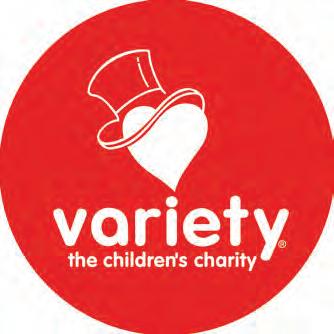
Support the CAR 000 Team
Variety Queensland is a children’s charity dedicated to assisting Queensland’s sick, disabled and disadvantaged kids by providing life enhancing and often life-saving goods and services such as wheelchairs, walkers, medical research funding, cochlear implants, computers and much more. To achieve this, Variety holds a multitude of fundraising events and ventures on a busy yearly schedule, the largest being the Queensland Variety Bash.

Queensland Ambulance Service (QAS) Retired Advanced Care Paramedic Wayne Tester has the ‘Car 000’. He has been a proud supporter of Variety Queensland since 1992 and has completed 29 Bashes and numerous other fundraising events. The Car 000 Team would like to give QAS employees the opportunity to continue to make contributions to Variety Queensland.
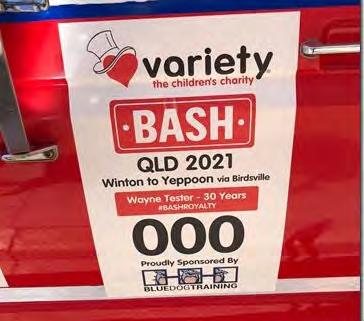
To make a one-off, weekly or monthly contribution, visit www.varietybashqld.com.au/wayne-tester
Please note that donations of $2 and above are fully tax-deductible.
For more information on Variety visit www.variety.org.au/qld
Variety Queensland is part of a world-wide volunteer organisation devoted to helping sick, disabled and disadvantaged children. It all started in Pittsburgh, USA, in 1927 when a group of 11 young men working in a theatre formed a social club called ‘Variety’.
On Christmas Eve in 1928 at a party in the Sheridan Theatre, Pittsburgh, an infant girl was found in the stalls of the theatre. Attached to the blanket in which the baby was wrapped, was a note; ‘Please take care of my baby. Her name is Catherine. I can no longer take care of her’, signed a broken-hearted mother.
Proving the heart of show business was in fact a big one, members of the first Variety Club decided to foster the baby. She was officially named Catherine Variety Sheridan. The members of the club set about ensuring Catherine was well provided for and in not time at all, she had more than one child could use. The club directed it attention to other needy children and thus began Variety!
For more information on the Queensland Variety Bash, please contact Ret. A.C. Paramedic Wayne Tester: call 0409 CAR 000, check out Facebook Car 000 or email car--000@bigpond.com
The Variety Story
























 Yvette D’Ath Minister for Health and Ambulance Services
Yvette D’Ath Minister for Health and Ambulance Services






























































































 ■ Sharon O’Connor.
Above
■ Townsville team.
In frame
■ Marko Isokangas and Bernadette Carnes.
■ Deputy Commissioner Dee Taylor-Dutton with Tracey Cater
■ Sharon O’Connor.
Above
■ Townsville team.
In frame
■ Marko Isokangas and Bernadette Carnes.
■ Deputy Commissioner Dee Taylor-Dutton with Tracey Cater














 ■ Peter Ball with colleagues Troy and Andrew.
Top to bottom
■ Doug Armstong with Russell Bowles.
■ Tanya Forsyth with Russell Bowles.
with Russell Bowles.
with Russell Bowles.
Scott.
■ Peter Ball with colleagues Troy and Andrew.
Top to bottom
■ Doug Armstong with Russell Bowles.
■ Tanya Forsyth with Russell Bowles.
with Russell Bowles.
with Russell Bowles.
Scott.










 Top to bottom, from left to right
■ Mikaela Ryan. ■ Dr Dan Bodnar. ■ Ryan McVeigh from Eatons Hill Station. ■ QPS and QAS challenge members. ■ Dr Dan Bodnar and Paramedic Caitlin Denning from Kedron Park. ■ Catherine Allen from Beenleigh station and Ebony Hewett from Southport Station.
Top to bottom, from left to right
■ Mikaela Ryan. ■ Dr Dan Bodnar. ■ Ryan McVeigh from Eatons Hill Station. ■ QPS and QAS challenge members. ■ Dr Dan Bodnar and Paramedic Caitlin Denning from Kedron Park. ■ Catherine Allen from Beenleigh station and Ebony Hewett from Southport Station.
















































































































 36 QAS Insight SPRING 2017
36 QAS Insight SPRING 2017













